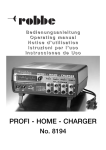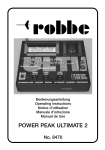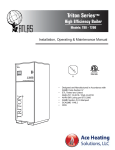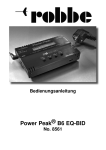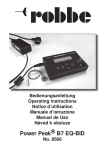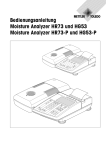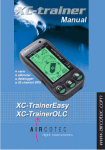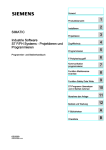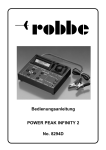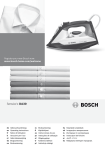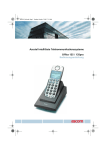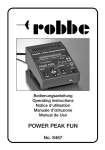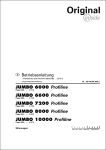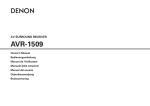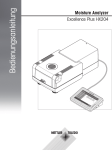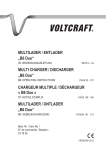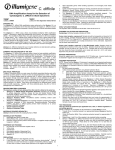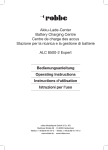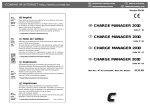Download Zusatzanleitung Ultimate Li.qxd
Transcript
Bedienungsanleitung Operating instructions Notice d’utilisation Manuale d’istruzione POWER PEAK MAXAMP No. 8121 Bedienungsanleitung Bestell Nr. POWER PEAK MAXAMP 8121 Allgemeines Mit dem MAXAMP können NICD- oder NIMH-Akkus von 1 bis 30 Zellen geladen bzw. entladen werden. Der maximale Ladestrom beträgt 12 A, der maximale Entladestrom 22 A. Es stehen die Funktionen LADEN, ENTLADEN , mehrfaches ENTLADEN-VOR-LADEN und mehrfaches LADEN -VOR-ENTLADEN zur Verfügung. Sicherheitshinweise - Bei längerem Nichtgebrauch das Ladegerät von der Spannungsquelle trennen und eventuell angeschlossene Akkus abnehmen. - Auf freie Kühlöffnungen zur Luftzirkulation achten. – Nicht auf Teppich oder Filz stellen. - Gerätefüße am Unterboden aufklappen. - Ladegerät und Akkus nicht auf brennbaren Unterlagen betreiben und nicht unbeaufsichtigt lassen. - Vor Feuchtigkeit schützen. - Auf richtige Polung aller Anschlüsse und Ausgänge achten. - Kurzschlüsse vermeiden. - Nicht direkter Sonneneinstrahlung aussetzen, Gerät nicht abdecken. - Keine Akkus laden, die stark erwärmt sind. Akkus auf Umgebungstemperatur abkühlen lassen. - Nur schnelladefähige und formierte Akkus verwenden. - Es dürfen nur Zellen gleicher Kapazität und gleichen Fabrikats im Verbund geladen werden. - Nicht zwei Akkus zum Laden parallel schalten. - Nur zum Laden von wiederaufladbaren Akkus geeignet. - Ladeströme der Höchstbelastung den am Akku befindlichen Kabeln und Steckverbindungen anpassen. - Ausgang und Eingang des Geräts nicht miteinander verbinden. Technische Daten Betriebsspannung: Stromaufnahme: Akkunennspannung: Ladestrom: Spannung: 0V ... 18V max. Strom: 12A Abschaltautomatik: Erhaltungsladung: Entladestrom: ca. 10 V ... 15 V leistungsfähige 12V Bleibatterie oder ein leistungsfähiges, gut stabilisiertes Netzteil (kein Ladegerät für Autobatterien verwenden!) max. ca. 40 A! 1,2 V ... 36,0 V (1 ... 30 NICD- / NIMH-Zellen) 0,1 A ... 12 A 18V ... 27V 8A 27V ... 36V 6A 36V ... 45V 5A über 45V 4A Delta-Peak-Verfahren und/oder Temperaturabschaltung keine 0,1 A ... 22 A Spannung: 0,1V ... 9V 9V ... 13V max. Strom: 22A 15A 13V ... 18V 18V ... 28V 28V ... 40V 40V ... 50V 11A 7A 5A 4A 3 Bedienungsanleitung Bestell Nr. POWER PEAK MAXAMP 8121 Schutzfunktionen: Ein- und ausgangsseitiger Verpolschutz, ausgangssei tiger Kurzschlußschutz, Übertemperaturschutz, Unterspannungsschutz 2 Stück, temperaturgeregelt 1 ... 8 NICD- / NIMH-Zellen, Ladestrom ca. 250 mA ca. 180 x 180 x 70 mm ca. 950 g Lüfter: TX / RX-Ausgang: Abmessungen: Gewicht: Bedienelemente RX/TX: Bananenbuchsen für RX-TX-Akku MODE-Taste START/STOP-Taste CURSOR-Tasten Eingang: Krokodilklemmen zum Anschluß an Spannungsquelle Ausgang: Krokodilklemmen zum Anschluß des zu ladenden Akkus UP/DOWN-Tasten Temperatursensor Inbetriebnahme - Die eingangsseitigen Krokodilklemmen an eine 12 V Bleibatterie oder ein entsprechendes Netzteil anschließen; unbedingt auf richtige Polung achten (rot = plus / schwarz = minus). - Im Display erscheint „robbe“, das Gerät ist einsatzbereit. - Den zu ladenden Akku polrichtig mit den ausgangsseitigen Krokoklemmen verbinden (rot = plus / schwarz = minus). Sollte ein direktes Verbinden des Akkus mit den Krokoklemmen nicht möglich sein, die Krokoklemmen unbedingt kurzschlußsicher über ein Ladekabel mit dem Akku verbinden. Falls höherwertige Stecksysteme anstelle der Krokoklemmen angebracht werden, müssen unbedingt auch die beiden dünnen Meßleitungen angeschlossen werden. - Im Display erscheint READY (betriebsbereit). - Wird als Abschaltkriterium die Temperaturabschaltung gewählt, muß der Temperatursensor thermisch gut leitend mit einem Klebeband am Akku fixiert werden. 4 Bedienungsanleitung Bestell Nr. POWER PEAK MAXAMP 8121 Bevor der eigentliche Lade- bzw. Entladevorgang gestartet werden kann, müssen die unten beschriebenen Parameter eingegeben werden. Das dazu erforderliche Einstellmenü erscheint nach Anschluß des Akkus. Im Folgenden wird angenommen, daß das Display im „LONG-DISPLAY“ Modus arbeitet. Der Modus kann durch die Doppeltastenfunktion (UP- und DN-Taste gleichzeitig kurz drücken) zwischen LONG und SHORT umgeschaltet werden. Darstellung des „SHORTDISPLAY“ siehe Anhang. Durch Blättern mit den UP- und DN-Tasten werden die einzustellenden Parameter ausgewählt und mit den CURSOR-Tasten eingestellt. Die linke und rechte Taste dient zur Auswahl der zu ändernden Ziffern, die obere und untere zur Änderung des ausgewählten Werts. - - - - Einstellung des Ladestroms: Auswahl von SET CH., Einstellen des Ladestroms mit den CURSOR-Tasten. Einstellung des Entladestroms: Auswahl von SET DC., Einstellen des Entladestroms mit den CURSOR-Tasten. Einstellung der Abschalttemperatur: Auswahl von S.CH.C.TEMP., Einstellen der Abschalttemperatur mit den CURSOR-Tasten. Einstellung der Delta-Peak-Empfindlichkeit: Auswahl von S.CH.DELTA, Einstellung der Delta-Peak-Empfindlichkeit mit den Cursor-Tasten. Einstellbare Werte für NICD Akkus liegen zwischen 3mV/Zelle und 20mV/Zelle. Zum Laden von NIMH Akkus muß der Wert 0DV eingestellt werden. Einstellung der Ladeschlußspannung: Auswahl von S.CH.CUT, generell auf den Maximalwert von 53 V einstellen. Einstellung der Entladeschlußspannung: Auswahl von S.DC.CUT, Einstellen der gewünschten Entladeschlußspannung mit den CURSOR-Tasten. Empfehlung: ca. 0,8 V pro Zelle. Die Eingabe der Parameter ist jetzt abgeschlossen. Mit der MODE-Taste kann zwischen LADEN (CHARGING), ENTLADEN (DISCHARGING), ENTLADEN-VOR-LADEN (DISC-CHAR 01TIME) und LADEN-VOR-ENTLADEN (CHAR-DISC 01TIME) gewählt werden. Die Anzahl der Zyklen (xxTIME) beim ENTLADEN-VOR-LADEN bzw. beim LADEN-VOR-ENTLADEN kann mit den CURSOR-Tasten zwischen 1 und 99 eingestellt werden. Gestartet wird die gewählte Betriebsart durch Betätigen der START/STOP-Taste. Beendet wird der Lade- bzw. Entladevorgang entweder durch die Abschaltautomatik (Delta-Peak- und/oder Temperaturabschaltung) oder durch Betätigung der START/STOP-Taste. Menü / Displays Die Menüstruktur: Die folgenden Displays können mit den UP- / DN-Tasten ausgewählt werden. Die oben beschriebenen Parameter werden mit den CURSOR-Tasten eingestellt. robbe OUTPUT 11.720 V Einschaltdisplay C Anzeige der momentanen Akkuspannung 5 OUTPUT +0.500 A C Bedienungsanleitung Bestell Nr. POWER PEAK MAXAMP 8121 Anzeige des momentanen Entladestroms (-) Ladestroms (+) bzw. M1 CH. 02120 mAh C Die letzten 5 eingeladenen Kapazitätswerte, auswählbar mit CURSOR Tasten M1 DC. 00000 mAh C Die letzten 5 entladenen Kapazitätswerte, auswählbar mit CURSOR Tasten PEAK 11.835 V C AVERAGE 10.719 V C Anzeige der Maximalspannung Anzeige der Durchschnittsspannung CH. TIME 01534S C Anzeige der Ladezeit DC.TIME 00000S C Anzeige der Entladezeit ENERGY 022.60Wh C Anzeige der eingeladenen / entladenen Energie TEMPERA. 31.0°C C Anzeige der Akkutemperatur SET CH. +05.00 A C Einstellung des Ladestroms SET DC. -08.00 A C Einstellung des Entladestroms S.CH.C.TEMP 38°C C Einstellung der Abschalttemperatur S. CH.DELTA10mVc C Einstellung der Delta-Peak Empfindlichkeit S. CH.CUT53.000V C Einstellung der Ladeschlußspannung S. DC.CUT05.600V C Einstellung der Entladeschlußspannung INPUT 12.33 V Anzeige der Eingangsspannung C 6 TX&RX 10.90V C Bedienungsanleitung Bestell Nr. POWER PEAK MAXAMP 8121 Anzeige der Akkuspannung am TX / RX Ausgang „C“ bedeutet CHARGING und kann je nach Zustand des Ladegerätes auch durch R = READY, D = DISCHARGING, D/C = DISC-CHAR (aktiver Zustand blinkt), C/D = CHAR-DISC (aktiver Zustand blinkt) oder N = NO BATTERY ersetzt sein. Alle angezeigten Parameter werden beim Anschließen eines Akkus oder beim Umschalten von Entladen auf Laden bzw. umgekehrt gelöscht, die Kapazitätswerte nach hinten (von M1 nach M2 ...) verschoben. Die Betriebsarten Die folgenden Betriebsarten werden mit der MODE-Taste ausgewählt und durch Betätigung der START / STOP-Taste aktiviert. CHARGING Einmaliges LADEN DISCHARGING Einmaliges ENTLADEN CHAR - DISC 01 TIME Mehrmaliges LADEN-VOR-ENTLADEN, Anzahl mit CURSOR Tasten einstellbar DISC - CHAR 03 TIME Mehrmaliges ENTLADEN-VOR-LADEN, Anzahl mit CURSOR Tasten einstellbar Weitere Displays NO BATTERY READY SHORT / REVERSE Kein Akku angeschlossen Betriebsbereit Akku verpolt bzw. Kurzschluß am Ausgang Ergänzende Hinweise - Die Auswahl des Abschaltkriteriums, Delta-Peak-Methode oder Temperaturabschaltung, erfolgt indirekt durch die Einstellungen von Abschalttemperatur und Delta-PeakEmpfindlichkeit. Wird als Abschaltverfahren die Delta-Peak-Methode gewählt, muß die Abschalttemperatur auf den Maximalwert von 60°C eingestellt werden. Soll nach dem Temperaturverfahren abgeschaltet werden, muß die Delta-Peak-Empfindlichkeit auf 7 - Bedienungsanleitung Bestell Nr. POWER PEAK MAXAMP 8121 den Maximalwert von 20 mV / Zelle und die Abschalttemperatur auf den gewünschten Wert eingestellt werden. Natürlich ist es auch denkbar, beide Verfahren quasi parallel zu verwenden, wobei das Temperaturverfahren gerade beim Laden mit hohen Laderaten zusätzliche Sicherheit gibt. Man wählt die gewünschte Delta-PeakEmpfindlichkeit und stellt eine Abschalttemperatur von z.B. 45°C ein. Beim Laden von NIMH-Akkus muß für die Delta-Peak-Empfindlichkeit der Wert 0DV eingestellt werden. Der Wert der Ladeschlußspannung hat beim Laden von NICD- und NIMH-Akkus keine Bedeutung und sollte auf den Maximalwert von 53 V eingestellt werden! Ansonsten erfolgt die Abschaltung der Ladung, sobald der eingestellte Wert erreicht ist. Allgemeines über das Laden und Entladen von Akkus Grundsätzlich sind die Hinweise der Akkuhersteller zu beachten, insbesondere die Hinweise über maximale Ladeströme. Um sicherzustellen, daß die Delta-Peak-Automatik optimal arbeiten kann, dürfen nur formierte Akkus schnellgeladen werden, d.h. neue oder längere Zeit nicht benutzte Akkus müssen in regelmäßigen Zeitabständen entladen und mit kleinen Laderaten, typischerweise C/10 formiert werden. Ein gelegentliches, vollständiges Entladen wirkt auch dem MEMORY-EFFEKT entgegen. Während das Laden von Senderakkus, die im Fernsteuersender eingebaut sind, möglich ist, stehen die Entladefunktionen nur dann zur Verfügung, wenn entweder die Verpolschutzdiode im Ladezweig des Senders überbrückt wird oder der Akku vom Sender getrennt und über ein Direktladekabel an das Ladegerät angeschlossen wird. Der Umbau des Senders sollte durch einen Fachmann, am Besten vom robbe-Service, durchgeführt werden. Empfohlene Direktladekabel No. 8262 F–Serien Sender No. 8263 Internationale Serie Anmerkungen - Beim Laden und Entladen von Akkus mit hohen Lade- bzw. Entladeraten kann - je nach Akkutyp - evtl. eine Kühlung des Akkus erforderlich sein. - Der maximale Lade- und Entladestrom hängt von der Zellenzahl des Akkus ab. Siehe „Technische Daten“. - Das Beenden des Ladens bzw. Entladens soll nicht durch Abziehen des Akkus erfolgen. Immer mit der START-STOP-Taste beenden. Laden von Sender- und Empfängerakkus am RX / TX-Ausgang Der RX / TX-Ausgang verfügt über keine Abschaltautomatik und dient zum Laden von Sender- und Empfängerakkus. Der Ladestrom beträgt ca. 250 mA und kann beim Laden von 8-zelligen Akkus unter Umständen je nach Spannungslage gegen Ende der Ladung leicht zurückgehen. Kurzschlüsse und Verpolungen über einen längeren Zeitraum sind zu vermeiden. Auf keinen Fall dürfen hier Akkus mit mehr als 8 Zellen angeschlossen werden. 8 Bedienungsanleitung Bestell Nr. POWER PEAK MAXAMP 8121 Anhang Short Display Anstelle des beschriebenen Anzeigeformats „LONG DISPLAY“, besteht auch die Möglichkeit, den „SHORT DISPLAY“ Modus zu wählen. Die Umschaltung zwischen beiden Anzeigemodi erfolgt mit der Doppeltastenfunktion der UP/DN-Tasten (Beide Tasten gleichzeitig kurz betätigen). Im Short-Display werden zuerst die Einheiten der Werte als Überschrift angezeigt, dann springt die Anzeige auf die entsprechenden Zahlenwerte. Durch kurzes Drücken der UPTaste können die Einheiten erneut angezeigt werden. 0.V. 0.A. C1mAh C 11.72V 5.00A 2120 C AVE. PEAK CH.T Einheiten Anzeige von Akkuspannung, Lade-/Entladestrom, eingeladener / entladener Kapazität Zahlenwerte C Anzeige von Durchschnittsspannung, Maximalspannung, Lade-/ Entladezeit 10.7V11.8V1534S C ENERGY TEMP. C Anzeige von eingeladener / entladener Energie und Akkutemperatur 0.22.60Wh 31.0°C C SCA SDA SDCV C 0.5.0A08.0A05.6V C Einstellung von Ladestrom, Entladeschlußspannung Entladestrom und SCCV SCCT SCDV C 53.00V38°C10mVc C I.V. TX&RX.V. C 12.33V 10.90V C Einstellung von Ladeschlußspannung, Abschalttemperatur und Delta-Peak-Empfindlichkeit Anzeige von Eingangsspannung und Akkuspannung am TX&RX-Ausgang Technische Änderungen vorbehalten 9 Operating instructions Order No. POWER PEAK MAXAMP 8121 Introduction The MAXAMP is designed for charging and discharging NiCD and NiMH batteries consisting of 1 to 30 cells. The maximum charge current is 12 A, the maximum discharge current 22 A. The following functions are available: CHARGE, DISCHARGE, multiple DISCHARGEBEFORE-CHARGE and multiple CHARGE-BEFORE-DISCHARGE. Safety notes · If the charger is not to be used for a protracted period, disconnect it from the power source and remove any battery packs connected to it. · Be sure to keep the cooling slots unobstructed to provide good air circulation - don’t stand the charger on a carpet or felt surface. · Unfold the feet fitted to the underside of the charger. · Do not set up the charger and batteries on a flammable surface, and never leave the unit operating unsupervised. · Protect the unit from damp. · Take care to maintain correct polarity at all connections and outputs. · Avoid short-circuits. · Don’t subject the charger to direct sunshine, and do not cover it. · Do not charge batteries which are already hot; allow them to cool down to ambient temperature before recharging. · Use only packs of fast-charge cells which have been properly balanced (equal state of charge). · Packs must consist of cells of the same make, type and capacity. · Do not wire two packs together in parallel for charging. · The unit is only suitable for use with rechargeable batteries. · Set charge currents within the maximum rated capacity of the cables and connectors attached to the battery pack. · Never connect any charger output to the input. Specification Operating voltage: Current drain: Nominal battery voltage: Charge current: Voltage: 0V … 18V Max. current: 12A approx. 10 V ... 15 V DC high-performance 12 V lead-acid battery or a powerful well stabilised mains PSU (do not use a car battery charger!) max. approx. 40 A! 1.2 V ... 36.0 V (1 ... 30 NiCD / NiMH cells) 0.1 A … 12 A 18V … 27V 27V … 36V 36V … 45V Over 45V 8A 6A 5A 4A Automatic charge termination: Delta Peak process and/or temperature monitoring Trickle charge: none Discharge current: 0.1 A … 22 A Voltage: 0.1V … 9V Max. current: 22A 9V … 13V 13V … 18V 18V … 28V 28V … 40V 40V … 50V 15A 11A 7A 5A 4A 10 Protective functions: Fans: TX / RX output: Dimensions: Weight: Operating instructions Order No. POWER PEAK MAXAMP 8121 Polarity protection at input and output, short-circuit protec tion at output, overheating protection, low voltage protection 2, temperature-controlled 1 … 8 NiCD / NiMH cells, charge current approx. 250 mA approx. 180 x 180 x 70 mm approx. 950 g Charger controls MODE button RX/TX Banana sockets for RX-TX battery START/STOP button CURSOR buttons Input: Crocodile clips for connection to power source Output: Crocodile clips for connection to battery to be charged UP/DOWN buttons Temperature sensor Using the charger · Connect the crocodile clips to a 12 V lead-acid battery or a suitable mains PSU; take great care over correct polarity (red = positive / black = negative). · The LCD screen will show „robbe“; the unit is ready to be set up. · Connect the battery pack to be charged to the output crocodile clips (red = positive / black = negative). If it is not possible to connect the battery directly to the crocodile clips, connect the crocodile clips to the battery using a charge lead, taking great care to avoid short-circuits. If you wish to fit high-quality connectors to the output leads instead of the crocodile clips, it is essential to connect the two thin measuring wires at the same time. · The screen now displays READY (ready for use). · If you select temperature monitoring as the termination criterion, the temperature sensor must be fixed to the battery with adhesive tape at a point which is an efficient thermal conductor. 11 Operating instructions Order No. POWER PEAK MAXAMP 8121 The parameters listed below must now be entered correctly before the actual charge or discharge process can be started. The setup menu required for this appears on the screen automatically when you connect the battery to be charged. In the following section we assume that the screen is set to „LONG DISPLAY“ mode. The display mode can be toggled between LONG and SHORT using the double button function (press the UP and DN buttons briefly together). See appendix for a screen short of the „SHORT DISPLAY“. The parameters to be set are selected initially by leafing through the menu using the UP and DN buttons; the value is set using the CURSOR buttons. The left and right buttons are used to select the numbers to be changed, the top and bottom buttons to change the selected value. - - - Setting the charge current: select SET CH, set the charge current using the CURSOR buttons. Setting the discharge current: select SET DC, adjust the discharge current using the CURSOR buttons. Setting the termination temperature: select S.CH.C.TEMP., adjust the termination temperature using the CURSOR buttons. Setting the Delta Peak sensitivity: select S.CH.DELTA, adjust the Delta Peak sensitivity using the cursor buttons. Values for NiCD packs are between 3mV/cell and 20mV/cell. For charging NiMH batteries the 0DV value must be set. Setting the final charge voltage: select S.CH.CUT, this should normally be set to the maximum value of 53 V. Setting the final discharge voltage: select S.DC.CUT, set the desired final discharge voltage using the CURSOR buttons. Recommendation: approx. 0.8 V per cell. This concludes the parameter setting process. By pressing the MODE button you can switch between CHARGING, DISCHARGING, DISCHARGE-BEFORE-CHARGE (DISC-CHAR 01TIME) and CHARGE-BEFOREDISCHARGE (CHAR-DISC 01TIME). The number of cycles (xxTIME) in the DISCHARGE-BEFORE-CHARGE and CHARGE-BEFORE-DISCHARGE processes can be set to any number in the range 1 - 99 using the CURSOR buttons. Press the START/STOP button to start the selected process. The charge or discharge process is ended by the automatic termination circuit (Delta Peak and/or temperature monitoring) or by the operator pressing the START/STOP button. Menus / screen displays The menu structure: the screen displays shown below can be selected using the UP / DN buttons. The parameters described above are set using the CURSOR buttons. robbe OUTPUT 11.720 V Power-on display C Display momentary battery voltage 12 OUTPUT +0.500 A C Operating instructions Order No. POWER PEAK MAXAMP 8121 Display momentary charge current (+) or discharge current (-) M1 CH. 02120 mAh C The last 5 charged-in capacity values can be selected using the CURSOR buttons M1 DC. 00000 mAh C The last 5 discharged capacity values can be selected using the CURSOR buttons PEAK 11.835 V C AVERAGE 10.719 V C Display maximum voltage Display average voltage CH. TIME 01534S C Display charge time DC.TIME 00000S C Display discharge time ENERGY 022.60Wh C Display charged-in / discharged energy TEMPERA. 31.0°C C Display battery temperature SET CH. +05.00 A C Set charge current SET DC. -08.00 A C S.CH.C.TEMP 38°C C Set discharge current Set termination temperature S. CH.DELTA10mVc C Set Delta Peak sensitivity S. CH.CUT53.000V C Set final charge voltage S. DC.CUT05.600V C Set final discharge voltage INPUT 12.33 V Display input voltage C 13 TX&RX 10.90V Operating instructions Order No. POWER PEAK MAXAMP 8121 C Display battery voltage at TX / RX output The letter „C“ means CHARGING, and may be replaced by R = READY, D = DISCHARGING, D/C = DISC-CHAR (active state flashes), C/D - CHAR-DISC (active state flashes) or N = NO BATTERY. All displayed parameters are erased when you connect a new battery, or switch from discharge to charge or vice versa, and the capacity values are shifted back by one place (from M1 to M2, etc.). Modes of operation The following modes of operation can be selected using the MODE button, and activated by pressing the START / STOP button. CHARGING Single CHARGE process DISCHARGING Single DISCHARGE process CHAR - DISC 01 TIME Multiple CHARGE-BEFORE-DISCHARGE process, number of cycles variable using CURSOR buttons DISC - CHAR 03 TIME Multiple DISCHARGE-BEFORE-CHARGE process, number of cycles variable using CURSOR buttons Additional screen displays NO BATTERY READY SHORT / REVERSE No battery connected Ready for use Battery connected with reverse polarity / short-circuit at output Additional information - The termination criterion (Delta Peak method or temperature monitoring) is selected indirectly by the settings you make relating to termination temperature and Delta Peak sensitivity. If you select the Delta Peak method of charge termination, the termination temperature must be set to the maximum value of 60ºC. If you wish the unit to terminate the charge process using temperature monitoring, Delta Peak sensitivity must be set to the maximum value of 20 mV/cell, and the termination temperature set to the desired 14 - Operating instructions Order No. POWER PEAK MAXAMP 8121 value. Of course, it is perfectly feasible to use both processes in parallel, in which case the temperature monitoring process provides an additional safety margin when charging at high currents. In this case you should select the desired Delta Peak sensitivity, and set a termination temperature of, say, 45ºC. When charging NiMH batteries the value for Delta Peak sensitivity must be set to 0DV. The value for final charge voltage is not relevant when charging NiCD and NiMH packs, and should be set to the maximum value of 53 V. If you set a different temperature, the charge process will terminate as soon as the pack reaches the set value. General information regarding charging and discharging batteries As a basic rule please be sure to observe the battery manufacturer’s recommendations, especially the information regarding maximum charge currents. To ensure that the automatic Delta Peak circuit is able to work as efficiently as possible, only properly balanced packs should be fast-charged. This means that new batteries, and packs which have not been used for a long time, should be discharged at regular intervals and re-balanced by slow-charging at a low rate, typically C/10. An occasional complete discharge process also helps to avoid and/or eliminate the MEMORY EFFECT. It is possible to charge a transmitter battery which is installed in the RC system transmitter, but the charger’s discharge functions are only available if you either by-pass the protective diode in the transmitter’s charge circuit, or remove the battery from the transmitter and connect it to the charger using a direct charge lead. Conversion work on the transmitter should only be carried out by an expert, ideally by your nearest robbe Service Centre. Recommended direct charge leads No. 8262 F-series transmitter No. 8263 International series Notes - When charging and discharging packs using high charge or discharge currents it may be necessary to allow the battery to cool down. This varies according to battery type. - The maximum charge and discharge currents vary according to the number of cells in the pack; see „Specification“. - Don’t end the charge or discharge process simply by disconnecting the battery pack; always stop the process by pressing the START/STOP button. Charging transmitter and receiver batteries at the RX / TX output The RX / TX output does not feature any form of automatic termination, and is designed for charging transmitter and receiver batteries. The charge current is approximately 250 mA, and this value may fall off slightly towards the end of the process when charging an 8-cell battery, depending on the pack’s voltage curve. Short-circuits and long-term reversed polarity must be avoided. Never connect a pack consisting of more than 8 cells to this output. 15 Operating instructions Order No. POWER PEAK MAXAMP 8121 Appendix Short Display The „SHORT DISPLAY“ mode can be selected instead of the „LONG DISPLAY“ mode, which has been described up to this point in these instructions. Press the UP and DN buttons simultaneously to toggle between these two display modes. In Short Display mode the screen initially displays the value units, then switches to the corresponding numeric values. The units can be displayed again by pressing the UP button briefly. 0.V. 0.A. C1mAh C 11.72V 5.00A 2120 C AVE. PEAK CH.T C Units Display battery voltage, charge / discharge current, chargedin / discharged capacity Numeric values Display average voltage, maximum voltage, charge / discharge time 10.7V11.8V1534S C ENERGY TEMP. C Display charged-in / discharged energy and battery temperature 0.22.60Wh 31.0°C C SCA SDA SDCV C Set charge current, discharge current and final discharge voltage 0.5.0A08.0A05.6V C SCCV SCCT SCDV C 53.00V38°C10mVc C I.V. TX&RX.V. C 12.33V 10.90V C Set final charge voltage, termination temperature and Delta Peak sensitivity Display input voltage and battery voltage at TX/RX output We reserve the right to alter technical specifications. 16 Notice d’utilisation Réf. POWER PEAK MAXAMP 8121 Généralités Avec le chargeur POWER PEAK MAXAMP est conçu pour la charge rapide et la décharge d’accus de 1 à 30 éléments Cd-Ni ou NiMH. Le courant de charge maximal est de 12 ampères et le courant de décharge maximal de 22 ampères. L’appareil propose les fonctions suivantes : CHARGE, DÉCHARGE, plusieurs DÉCHARGES-AVANT CHARGES, et plusieurs CHARGES-AVANT DÉCHARGES. Consignes de sécurité : - Lorsqu’il est prévu de ne pas utiliser l’appareil pendant un certain temps, le désolidariser du secteur et en retirer les accus encore en place. - Veiller à laisser dégagées les fentes de refroidissement afin de permettre à l’air de circuler. Ne pas l’installer sur un tapis ou du feutre pour une procédure d charge. - Rabattre les pieds du fond de l’appareil vers l’extérieur. - Ne pas disposer les accus et l’appareil sur un support inflammable et ne jamais les laisser sans surveillance. - Protéger le chargeur de l’humidité. - Observer les polarités de tous les branchements et les sorties. Éviter les courts-circuits. - Ne jamais exposer l’appareil au rayonnement direct du Soleil. Ne pas couvrir l’appareil lorsqu’il est en service. - Ne pas mettre en charge des accus particulièrement chauds. Avant de les charger, laisser refroidir les accus à température ambiante. - N’utiliser que des accus propres à une charge rapide et parfaitement homogènes. - N’utiliser que des éléments de capacité égale et de même fabrication assemblés en accus. - Ne pas raccorder deux accus en parallèle pour les charger. - Le chargeur n’est conçu que pour la charge d’accu effectivement rechargeables. - Ajuster les courants de charge les plus élevés aux connecteur et cordon solidaires des accus. - Ne pas raccorder entre elles les entrées et les sorties. Caractéristiques techniques Tension de service : Consommation : Tension nominale de l’accu : Courant de charge : Tension: Cour. max. 0V ... 18V 12A approx. 10 à 15 volts CC accu 12 volts de voiture à capacité appropriées ou bloc d’alimentation secteur puissant et parfaitement stabilisé (ne pas utiliser de chargeur pour batterie de voiture). maximale approx. 40 A 1,2 volt à 36,0 volts (1 à 30 éléments Cd-No / NiMH 0,1 A à 12 18V ... 27V 8A 27V ... 36V 6A 36V ... 45V 5A plus de 45V 4A Commutation en fin de charge: Système Delta-Peak ou par commutation thermique Courant de charge de maintien:néant Courant de décharge: 0,1 à 22 A Tension: Cour. max.: 0,1V ... 9V 9V ... 13V 22A 15A 13V ... 18V 18V ... 28V 28V ... 40V 40V ... 50V 11A 7A 5A 4A 17 Notice d’utilisation Réf. POWER PEAK MAXAMP 8121 Fonctions de protection : protection contre les inversions de polarité des entrées et des sor ties, protection contre les courts-circuits côté sortie., protection con tre les températures excessives et contre les tensions insuffisantes. Ventilateur : 2 unités avec thermorégulation Sortie TX/RX : 1 à 8 éléments Cd-Ni / NiMH, courant de charge de 250 mA environ Encombrement : approx. 180 x 180 x 70 mm Poids : approx. 950 g Éléments de commande Touche de MODE RX/TX : Touche MARCHE/ARRET connecteurs douilles banane pour accus Rx/Tx Touches CURSEUR Entrée: pinces crocodile pour connexion à la source d’alimentation Sortie : pinces crocodile pour connexion à l’accu à charger Touches UP/DOWN Thermocapteur Mise en service - Raccorder les pinces crocodile à une batterie au plomb de 12 volts ou à bloc d’alimentation secteur approprié ; veiller absolument à respecter les polarités (rouge = plus / noir = moins) - cf. également le paragraphe « Bloc d’alimentation secteur ». - Sur l’écran apparaît la mention « robbe », l’appareil est en ordre de marche. - Raccorder l’accu à charger en respectant les polarités avec les pinces crocodile côté sortie (rouge = plus / noir = moins). S’il s’avérait impossible de raccorder les pinces crocodile, les protéger contre les courts circuits.Si vous utilisez un système de connexion de qualité supérieure aux pinces crocodile, il faut également raccorder absolument les deux brins métalliques des conduites de mesure. - Sur l’écran apparaît la mention READY (en ordre de marche). - Lorsque la température est choisie comme critère de commutation en fin de charge, il faut fixer le capteur de température avec un morceau de ruban adhésif à l’accu afin que la chaleur soit parfaitement conduite. 18 Notice d’utilisation Réf. POWER PEAK MAXAMP 8121 Avant de lancer une procédure de charge ou de décharge proprement dite, il faut saisir les paramètres présentés ci-dessous. Le menu de mise au point indispensable apparaît après connexion de l’accu d’alimentation. Dans les paragraphes qui suivent, ont part du principe que l’écran travaille en mode « LONG-DISPLAY ». Il est possible de choisir entre les menu LONG et SHORT pour la représentation sur l’écran en actionnant brièvement simultanément les touches UP et DN. Pour la représentation courte « SHORT » sur l’écran, cf. en annexe. L’écran permet avec les touches UP et DN de sélectionner à l’aide des touches du CURSEUR les paramètres à mettre au point. La touche gauche et la touche droite permettent de sélectionner les chiffres à modifier et les flèches du haut et du bas à changer les valeurs sélectionnées. - - - - Réglage du courant de charge : sélectionner SET CH. Régler le courant de charge avec les touches du CURSEUR. Réglage du courant de décharge : sélectionner SET DC. Régler le courant de décharge avec les touches du CURSEUR. Réglage de la température de coupure : sélectionner S.CH.C.TEMP., régler la température de coupure à l’aide des touches du CURSEUR. Réglage de la sensibilité Delta-Peak : sélectionner S.CH.DELTA., régler la sensibilité du système Delta-Peak à l’aide des touches du CURSEUR. Les valeurs réglables pour les accus Cd-Ni varient entre 3mV/élément et 20mV/élément. Pour charger les accus NiMH, il faut régler la valeur 0DV. Réglage de la tension en fin de charge : sélectionner S.CH.CUT, généralement c’est la valeur maximale de 53 V qui est établie. Réglage de la tension en fin de décharge : sélectionner S.DC.CUT, sélectionner la tension de fin de décharge souhaitée à l’aide des touches du CURSEUR. Nous recommandons une valeur de 0,8 volt environ par élément. La saisie des paramètres est ainsi achevée. À l’aide de la touche MODE vous avez maintenant la possibilité de choisir entre CHARGE (CHARGING), DÉCHARGE (DISCHARGING), DÉCHARGE-AVANT CHARGE (DISC-CHAR 01TIME) et CHARGE-AVANT DÉCHARGE (CHAR-DISC 01TIME). Le nombre de cycles (xxTIME) pour DÉCHARGE-AVANT CHARGE et CHARGE-AVANT DÉCHARGE peut être sélectionné à l’aide des touches de cusrseur entre 1 et 99. Le mode choisi est lancé en actionnant la touche MARCHE/ARRET (START/STOP). La procédure de charge ou de décharge s’arrête soit en mode automatique (Delta-Peak ou/et coupure en fonction de la température) ou en actionnant la touche MARCHE/ARRET (START/STOP). Écrans à menu La structure du menu : les écrans suivants peuvent être sélectionnés à l’aide des touches UP / DN. Les paramètres décrits ci-dessous sont mis au point à l’aide des touches de CURSEUR. robbe OUTPUT 11.720 V Écran de mise en marche C Affichage de la tension momentanée de l’accu 19 Notice d’utilisation Réf. POWER PEAK MAXAMP 8121 C Affichage du courant de charge (+) ou de décharge (-) momentané M1 CH. 02120 mAh C Les 5 dernières valeurs de capacité chargées, sélectionnables à l’aide des touches du CURSEUR. M1 DC. 00000 mAh C Les 5 dernières valeurs de capacité déchargées, sélectionnables à l’aide des touches du CURSEUR. OUTPUT +0.500 A C Affichage de la tension maximale AVERAGE 10.719 V C Affichage de la tension moyenne PEAK 11.835 V CH. TIME 01534S C Affichage de la durée de la charge DC.TIME 00000S C Affichage de la durée de la décharge ENERGY 022.60Wh C TEMPERA. 31.0°C C Affichage de l’énergie chargée / déchargée Affichage de la température de l’accu SET CH. +05.00 A C Réglage du courant de charge SET DC. -08.00 A C Réglage du courant de décharge S.CH.C.TEMP 38°C C Réglage de la température de coupure S. CH.DELTA10mVc C Réglage de la sensibilité Delta-Peak S. CH.CUT53.000V C Réglage de la tension en fin de charge S. DC.CUT05.600V C Réglage de la tension en fin de décharge INPUT 12.33 V Affichage de la tension d’alimentation du chargeur C 20 TX&RX 10.90V C Notice d’utilisation Réf. POWER PEAK MAXAMP 8121 Affichage de la tension de l’accu à la sortie TX/RX. « C » signifie CHARGING et peut, en fonction de l’état du chargeur, être remplacé par R = READY, D = DISCHARGING, D/C = DISC-CHAR (l’état activé clignote), C/D = CHARDISC (l’état activé clignote) ou N = NO BATTERY. Tous les paramètres affichés sont effacés lorsqu’on raccorde un accu ou lorsqu’on commute de décharge sur charge et inversement, les valeurs de capacité sont décalées vers l’arrière (de M1 vers M2 ....). Les modes Les modes suivants peuvent être sélectionnés à l’aide de la touche MODE et activés en actionnant la touche START/STOP. CHARGING CHARGE unique DISCHARGING DÉCHARGE unique CHAR - DISC 01 TIME Plusieurs CHARGES-AVANT DÉCHARGES, sélectionner le nombre de cycles à l’aide des touches du CURSEUR. DISC - CHAR 03 TIME Plusieurs DÉCHARGES-AVANT CHARGES, sélectionner le nombre de cycles à l’aide des touches du CURSEUR. Autres écrans NO BATTERY Pas d’accu raccordé READY En ordre de marche SHORT / REVERSE Polarités inversées de l’accu ou court-circuit à la sortie Informations complémentaires : - La sélection du critère de coupure en fin de charge, c’est-à-dire la méthode DeltaPeak ou la coupure en fonction de la température, intervient indirectement par la mise au point des valeurs de la température de coupure et de la sensibilité Delta-Peak. Si l’on opte pour la méthode Delta-Peak de coupure automatique en fin de charge, il faut disposer la température de coupure sur la valeur maximale de 60° C. Si l’on opte pour la méthode de coupure automatique en fin de charge en fonction de la température, il faut régler la sensibilité Delta-Peak sur la valeur maximale de 20 mV par élément et la 21 - Notice d’utilisation Réf. POWER PEAK MAXAMP 8121 valeur de commutation de la température au choix. Il est bien sûr également possible d’utiliser les deux méthodes à la fois, pratiquement en parallèle, la procédure de température offrant toutefois plus de sécurité pour les charges à taux de charge élevés. On sélectionne alors la sensibilité Delta-Peak souhaitée et on règle la température de coupure sur, par exemple, 45° C. Pour charger les accus NiMH il faut régler la sensibilité Delta-Peak sur la valeur 0DV. La valeur de tension de fin de charge pour la charge des accus Cd-Ni et des accus NiMH n’a pas de signification et doit être réglée sur la valeur maximale de 53 V. Sinon la charge est interrompue dès que la valeur réglée est atteinte. Généralités concernant la charge et la décharge d’accus Il faut en règle générale observer formellement les recommandations du fabricant de l’accu, particulièrement en ce qui concerne les courants de charge maximaux. Pour s’assurer que le dispositif de commutation automatique Delta-Peak en fin de charge fonctionne correctement, il ne faut mettre en charge rapide des accus dont les éléments sont parfaitement homogènes, c’est-à-dire que les accus neufs ou qui n’ont pas été utilisés depuis un certain temps doivent être déchargés à intervalles réguliers ou être formés avec de petits chargeurs assurant une charge de type C/10. Une décharge complète de temps en temps a aussi un effet contre l’effet de mémoire des accus. Pendant la charge d’accus d’émetteur installés dans l’émetteur, ce qui est possible, les fonctions de décharge ne sont cependant disponibles que lorsque la diode de protection contre les inversions de polarité est shuntée au niveau du branchement de charge de l’émetteur ou lorsque l’accu est désolidarisé de l’émetteur et raccordé directement au chargeur par un cordon de charge directe. La transformation nécessaire au niveau de l’émetteur doit être confiée à un spécialiste et de préférence au service après-vente robbe. Cordons de charge directe recommandés réf. 8262 émetteurs de la série F réf. 8263 série internationale Remarques - Pour la charge ou la décharge d’accus à hauts taux de charge ou de décharge il peut s’avérer indispensable - selon le type d’accu - d’assurer un refroidissement des accus. - Le courant de charge ou de décharge maximal dépend du nombre des éléments de l’accu, cf. « Caractéristiques techniques ». - La fin de la charge ou de la décharge ne doit jamais intervenir en retirant l’accu du chargeur. La stopper à l’aide de la touche START-STOP. Charge d’accus d’émetteur et de récepteur à la sortie RX/TX La sortie RX/TX ne dispose pas d’automatisme de coupure en fin de charge, elle est conçue pour la charge d’accus d’émission et de réception. Le courant de charge est de 250 mA environ, il est susceptible de diminuer légèrement en fin de charge avec des accus de 8 éléments dans certaines circonstances et en fonction du niveau de charge. Les courts-circuits et les inversions de polarité sont à éviter à long terme. En aucun cas ne raccorder des accus de plus de 8 éléments à cette sortie. 22 Notice d’utilisation Réf. POWER PEAK MAXAMP 8121 Annexe Écran abrégé En remplacement du format d’affichage „LONG DISPLAY“ décrit antérieurement, il est possible de choisir un mode d’affichage abrégé („SHORT DISPLAY“). La commutation entre les deux types d’affichages intervient à l’aide des touches UP/DN actionnées brièvement et simultanément. L’écran abrégé présente d’abord la dénomination des valeurs mémorisées en titre puis il saute sur les valeurs elles-mêmes. Une action brève sur la touche UP permet de revenir aux unités. 0.V. 0.A. C1mAh C 11.72V 5.00A 2120 C AVE. PEAK CH.T C Unités Affichage de la tension de l’accu, du courant de charge/décharge, de la capacité chargée/déchargée. Valeurs chiffrées Affichage de la tension moyenne, de la tension maximale et de la durée de la charge/décharge. 10.7V11.8V1534S C ENERGY TEMP. C Affichage de l’énergie chargée/déchargée et de la température de l’accu. 0.22.60Wh 31.0°C C SCA SDA SDCV C Réglage du courant de charge, du courant de décharge et de la tension en fin de décharge. 0.5.0A08.0A05.6V C SCCV SCCT SCDV C 53.00V38°C10mVc C I.V. TX&RX.V. C 12.33V 10.90V C Réglage de la tension en fin de charge, de la température de commutation en fin de charge et de la sensibilité Delta-Peak. Affichage de la tension d’admission et de la tension de l’accu à la sortie Tx/Rx. Sous réserve de modification technique. 23 Manuale d’istruzione Codice POWER PEAK MAXAMP 8121 Introduzione Il MAXAMP è un caricabatteria automatico progettato per la carica , scarica e manutenzione di pacchi batterie sia NICD che NIMH da 1 a 30 celle con fine carica gestito dal sistema a lettura di picco “Delta Peak“. La corrente massima di carica è di 12 A, mentre la corrente massima si scarica è di 22 A. Norme di Sicurezza - Se il caricabatteria rimane inutilizzato per un periodo prolungato è consigliabile scollegare sia l’alimentazione di ingresso e sia ogni batteria in uscita. - Assicurarsi di mantenere le feritoie di aerazione pulite e senza impedimento alcuno al fine di assicurare una corretta circolazione d’aria per il raffreddamento. - Aprire i supporti al involucro posteriore. - Non utilizzare il caricabatteria appoggiato ad una superficie infiammabile e non lasciare mai l’apparecchio incustodito durante il processo di carica-scarica. - Proteggere l’apparecchio da eventuali urti - Prestare attenzione a non invertire le polarità di alimentazione in ingresso ed uscita. - Evitare corti circuiti - Non lasciare il caricabatteria al sole ed evitare di coprirlo durante l’uso - Non caricare batterie già calde: lasciarle raffreddare fino alla temperatura ambiente prima della ricarica. - Utilizzare solo pacchi a carica rapida precedentemente “bilanciati” con una carica-scarica lenta. - I pacchi devono essere formati da celle uguali tra loro: non mescolare celle di capacità e marche diverse. - Non collegare due pacchi in parallelo per la ricarica - Il POWER PEAK MAXAMP è progettato solamente per essere impiegato per la carica di batterie ricaricabili. Selezionare correnti di carica comprese nei valori massimi suggeriti dal costruttore e proporzionati al cavo e/o connettore della batteria utilizzata. - Mai collegare un altro caricabatteria all’uscita. Specifiche Tensione di alimentazione : Corrente assorbita: Tensione nominale batteria uscita Corrente di carica : Voltaggio: 0V ... 18V Corr. mass.: 12A Interruzione carica: Carica di mantenimento: Corrente di scarica : 10 V ... 15 V DC circa Batteria al piombo o alimentatore stabilizzato e ben fil trato alimentato a rete. (NON UTILIZZARE MAI UN CARICABATTERIE 12V D’AUTO) 40 A circa massimo 1,2V….36.0V (1….30 elementi per NICD/NIMH) 0,1 A ... 12 A 18V ... 27V 8A 27V ... 36V 6A 36V ... 45V 5A 45V...... 4A a lettura di picco “ Delta Peak “ e/o a temperatura niente carica di mantenimento 0,5 A ... 22,0 A programmabile Voltaggio: 0,1V ... 9V 9V ... 13V Corr. mass.: 22A 15A 13V ... 18V 18V ... 28V 28V ... 40V 40V ... 50V 11A 7A 5A 4A 24 Protezioni: Ventole: Uscita TX/RX Dimensioni: Peso Manuale d’istruzione Codice POWER PEAK MAXAMP 8121 Inversione di polarità ingresso uscita, corto circuito in uscita, prote zione contro il surriscaldamento, protezione in caso di alimentazione d’ingresso bassa, protezione alta tensione 2 controllate da termostato 1…8 Celle sia NiCd che NiMh con corrente di carica di circa 250mA 180 x 180 x 70 mm 950 g. Funzioni Tasto scelta modalità d’uso Tasto di START/STOP RX/TX Boccole uscita per Tasti CURSORE batterie RX-TX. Entrata: Coccodrilli di ingresso per entrata 12 Vcc USCITA: coccodrilli per il collegamento della batteria da caricare Tasti SALITA/DISCESA Sensore di temperatura Uso del caricabatteria - Connettere I coccodrilli d’ingresso alla batteria 12 V oppure ad un appropriato alimentatore stabilizzato prestando particolare attenzione alle polarità. - Lo schermo a cristalli liquidi LCD mostrerà la scritta “robbe“ indicando che il caricabatteria è pronto per l’uso. - Collegare il pacco batterie da caricare ai coccodrilli d’uscita avendo cura di rispettare le polarità. (Rosso = positivo. Nero = negativo). Nel caso non sia possibile collegare i coccodrilli direttamente alla batteria da caricare collegateli ad un cavo di ricarica evitando accuratamente inversioni di polarità e cortocircuiti. Se si desidera sostituire i coccodrilli in uscita con connettori di alta qualità è essenziale collegare i due cavi contemporaneamente. - Sullo schermo apparirà ora la scritta READY (pronto all’uso) - Se viene scelto il monitoraggio della temperatura per la gestione del fine carica il sensore di temperatura deve essere fissato saldamente alla batteria da caricare con del nastro adesivo in un punto dove il calore si propaga facilmente. 25 Manuale d’istruzione Codice POWER PEAK MAXAMP 8121 I parametri descritti di seguito devono essere ora inseriti correttamente prima di iniziare il processo di carica o scarica. Nella sezione seguente si suppone che lo schermo LCD visualizzi la schermata “LONG DISPLAY” (letteralmente “LUNGA SCHERMATA” che visualizza informazioni più dettagliate). La scelta tra “LONG DISPLAY” o “SHORT DISPLAY” può essere effettuata premendo contemporaneamente per alcuni istanti i tasti “UP” e “DOWN”. Consultare l’appendice per una breve descrizione della funzione SHORT DISPLAY. I parametri da programmare sono selezionabili scorrendo il menù utilizzando i tasti UP e DOWN ; il valore desiderato può essere impostato premendo i tasti CURSORE (CURSOR). Premere i tasti destro (right) o sinistro (left) per selezionare il valore che si desidera modificare, i tasti sopra (UP e sotto (DOWN) cambieranno il valore selezionato. - - - - Come fissare la corrente di carica: selezionare la videata SET CH ed impostare il valore di corrente desiderato utilizzando i tasti CURSORE (CURSOR). Come fissare la corrente di scarica: selezionare la videata SET DC ed impostare il valore di corrente desiderato utilizzando i tasti CURSORE (CURSOR). Come fissare la temperatura di fine carica: selezionare la videata S.CH.C.TEMP., ed impostare la temperatura desiderata utilizzando i tasti CURSORE (CURSOR). Come fissare la sensibilità del Delta Peak: selezionare la videata S.CH. DELTA, ed impostare il valore desiderato utilizzando i tasti CURSORE (CURSOR). Scegliere per pacchi al NiCd un valore compreso tra 3 mV/cella e 20 mV/cella. Per la ricarica di batterie NiMh è necessario invece impostare il valore ODV. Come fissare il valore di tensione di fine carica: selezionare la videata S.CH.CUT, normalmente viene impostato il valore massimo di 53V. Come fissare il valore di tensione di fine scarica: selezionare la videata S.DC.CUT, ed impostare il valore desiderato utilizzando i tasti CURSORE (CURSOR). Raccomandiamo un valore di 0,8 V per elemento. Sin qui l’impostazione dei vari parametri di carica/scarica. Premendo il tasto MODE è possibile scegliere la modalità di CHARGING (CARICA), DISCHARGING (SCARICA), DISC-CHAR 01 TIME (SCARICA-CARICA 1 VOLTA), CHAR-DISC 01 TIME (CARICA-SCARICA 1 VOLTA). Il numero di cicli di carica nell’opzione SCARICA-CARICA e CARICA-SCARICA può essere scelto tra un numero compreso tra 1 e 99 utilizzando sempre i tasti CURSORE. Premere il tasto START/STOP per iniziare il processo di carica e/o scarica selezionato. Il ciclo di carica o scarica può concludersi a lettura di picco, lettura di temperatura oppure premendo nuovamente il tasto START/STOP. La carica o scarica può essere interrotta automaticamente oppure manualmente dall’utente premendo il tasto START/STOP. Videate/Displays La struttura delle videate: Le seguenti videate possono essere scelte premendo i tasti UPDN. I parametri sopra descritti vengono impostate con i tasti CURSOR(E). robbe Caricabatteria acceso Tensione batteria in carica OUTPUT 11.720 V C 26 OUTPUT +0.500 A C Manuale d’istruzione Codice POWER PEAK MAXAMP 8121 Corrente di carica (+) o scarica (-) batteria M1 CH. 02120 mAh C Gli ultimi 5 valori di capacità di carica possono essere visualizzati utilizzando i tasti CURSOR(E) M1 DC. 00000 mAh C Gli ultimi 5 valori di capacità di scarica possono essere visualizzati utilizzando i tasti CURSOR(E) PEAK 11.835 V C AVERAGE 10.719 V C Visualizzazione picco massimo di tensione Visualizzazione voltaggio medio batteria in uscita CH. TIME 01534S C Visualizzazione tempo di carica DC.TIME 00000S C Visualizzazione tempo di scarica ENERGY 022.60Wh C Visualizzazione dell’energia di carica o scarica TEMPERA. 31.0°C C Visualizzazione della temperatura di batteria SET CH. +05.00 A C Scelta del valore della corrente di carica. SET DC. -08.00 A C S.CH.C.TEMP 38°C C Scelta del valore della corrente di scarica. Scelta del valore della temperatura di interruzione carica. S. CH.DELTA10mVc C Scelta del valore della sensibilità del DELTA PEAK. S. CH.CUT53.000V C Scelta del valore del valore finale di tensione di fine carica. S. DC.CUT05.600V C Scelta del valore del valore finale di tensione di fine scarica. INPUT 12.33 V Visualizzazione della tensione in ingresso. C 27 TX&RX 10.90V C Manuale d’istruzione Codice POWER PEAK MAXAMP 8121 Visualizzazione della tensione della batteria collegata sull’uscita TX RX La lettera C indica la carica in corso. Al suo posto possono anche apparire le seguenti lettere: R=READY (PRONTO), D=DISCHARGE(SCARICA IN CORSO), D/C = DISC-CHAR (SCARICA-CARICA), C/D = CHAR-DISC (CARICA-SCARICA) dove lo stato di carica o scarica è evidenziato dalla lettera relativa lampeggiante ed infine N che indica l’assenza di batteria da caricare collegata all’uscita. (NO BATTERY) Tutti i parametri visualizzati vengono cancellati collegando una nuova batteria oppure commutando da scarica in carica e viceversa. I valori di capacità vengono slittati di un posto (da M1 a M2, ecc). Modalità d’uso Possono essere selezionate le seguenti modalità d’uso premendo il tasto MODE e successivamente attivate premendo il tasto START/STOP. CHARGING Processo di carica singolo DISCHARGING Processo di scarica singolo CHAR - DISC 01 TIME Ciclo di carica-scarica: il numero dei cicli può essere variato dai tasti CURSOR(E) DISC - CHAR 03 TIME Ciclo di scarica-carica: il numero dei cicli può essere variato dai tasti CURSOR(E) Informazioni aggiuntive visualizzate sullo schermo LCD NO BATTERY READY SHORT / REVERSE Nessuna batteria collegata in uscita. Pronto all’uso Batteria in uscita collegata con polarità invertita oppure in corto circuito Informazioni supplementari - Il criterio di fine carica (sistema Delta Peak o lettura della temperatura) è indirettamente selezionata dalla scelta effettuata: delta peak oppure a temperatura. Se viene selezionato il sistema a lettura di picco “Delta Peak” il limite di temperatura deve essere portato al valore massimo di 60° C mentre se si sceglie d’interrompere la carica “monitorando” la temperatura è necessario fissare il valore di sensibilità a 20mV/cella e il valore massimo di temperatura al quale si vuole far interrompere la carica. I due sistemi di gestione del fine carica possono essere anche utilizzati in “parallelo” . In questo modo il monitoraggio della temperatura fornirà una sicurezza ulteriore specialmente nella carica di batterie con correnti molto elevate. Si consiglia di scegliere la sensibilità 28 - Manuale d’istruzione Codice POWER PEAK MAXAMP 8121 desiderata del Delta Peak e di fissare una temperatura massima di 45° C Durante la carica di batterie NiMh il valore del Delta Peak deve essere impostato a 0DV Il valore della tensione finale è un dato irrilevante sia per le NiCd che per NiMh ed è opportuno impostare il valore massimo consentito dal caricabatteria: 53 V. Nel caso si selezionasse una temperatura differente la carica sarà interrotta al raggiungimento della temperatura impostata. Informazioni generali sulla carica e scarica delle batterie Come regola generale assicuratevi di osservare sempre le raccomandazioni del costruttore delle batterie in vostro possesso e che vi accingete a ricaricare con particolare attenzione alla corrente massima di carica e scarica. Per essere sicuri che il sistema a lettura di picco funzioni il più correttamente possibile si raccomanda di caricare con carica rapida solo pacchi bilanciati. Questo significa che ogni nuovo pacco o pacchi rimasti inattivi per un lungo periodo dovrebbero essere scaricati ad intervalli regolari e ricaricati con carica lenta con corrente pari a 1/10 della capacità nominale. Una scarica completa da ripetersi di tanto in tanto aiuta anche a prevenire ed eliminare il tipico EFFETTO MEMORIA delle batterie NICD. Alcuni vecchi pacchi o batterie di bassa qualità possono impedire il corretto funzionamento del caricabatteria. In questi casi si raccomanda di tenere il caricabatteria costantemente sotto controllo durante la fase di carica e scarica. È possibile caricare pacchi TX che normalmente sono installati all’interno del trasmettitore. In questo caso la funzione di scarica non può essere utilizzata senza prima rimuovere il pacco dal trasmettitore oppure senza aver ponticellato il diodo di protezione all’interno del radiocomando. Si raccomanda di far eseguire quest’ultima operazione dal centro assistenza ROBBE più vicino. Cavo di ricarica raccomandato per collegamento diretto No. 8262 per radio serie F No. 8263 tutte le radio FUTABA Alcune Note - Nella carica/scarica di pacchi batterie con elevate correnti è necessario, prima del loro utilizzo, lasciarle raffreddare - La corrente di carica e scarica massima varia in ragione del numero di celle collegate: vedere le specifiche per ulteriori dettagli. - Non interrompere la carica o scarica semplicemente scollegando la batteria collegata: interrompete il processo in corso premendo il tasto MODE (START-STOP). Ricarica delle batterie trasmittente e ricevente collegate all’uscita RX/TX. L’uscita RX/TX non è gestita da alcun tipo di automatismo ed è progettata per la ricarica del pacco TX o RX. La corrente di carica è di circa 250 MA fissa. Il suo valore può essere leggermente inferiore in presenza di un pacco da 8 celle verso la fine della carica. É consigliabile evitare corto circuiti e periodi lunghi con batteria collegata a polarità invertita. Non collegare mai un pacco superiore alle 8 celle su quest’uscita. 29 Manuale d’istruzione Codice POWER PEAK MAXAMP 8121 Appendice. SHORT DISPLAY Al posto della modalità LONG DISPLAY è possibile selezionare l’opzione SHORT DISPLAY. Premer i tasti UP e DN simultaneamente per passare da una modalità all’altra. Nell’opzione SHORT DISPLAY lo schermo visualizza inizialmente i valori unitari. I corrispondenti valori numerici appariranno subito dopo. E’ possibile passare ai valori unitari nuovamente premendo brevemente il tasto UP. 0.V. 0.A. C1mAh C 11.72V 5.00A 2120 C AVE. PEAK CH.T Dati Visualizzati Tensione di batteria, corrente di carica/scarica, quantità di carica e scarica Valori numerici C Visualizzazione voltaggio medio, picco massimo, tempo di carica e scarica 10.7V11.8V1534S C ENERGY TEMP. C Visualizzazione energia di carica/scarica e temperatura di batteria 0.22.60Wh 31.0°C C SCA SDA SDCV C 0.5.0A08.0A05.6V C Programmazione della corrente di carica, corrente di scarica e voltaggio minimo di scarica. SCCV SCCT SCDV C 53.00V38°C10mVc C I.V. TX&RX.V. C 12.33V 10.90V C Programmazione del voltaggio finale di carica, temperatura massima di fine carica e sensibilità del “Delta peak” Visualizzazione tensione di ingresso e della batteria collegata all’uscita TX&RX Ci riserviamo il diritto di apportare ogni eventuale variazione tecnica senza che questo costituisca obbligo alcuno nei confronti dell’acquirente. Ogni diritto riservato 30 robbe Modellsport GmbH & Co. KG Metzloserstr. 36 Telefon: 06644 / 87-0 36355 Grebenhain FAC Ergänzungsanleitung Supplementary Instructions Notice Complémentaire Istruzioni Aggiuntive Instrucciones Adicionales POWER PEAK MAXAMP LI No. 8121 Ergänzungsanleitung POWER PEAK MAXAMP LI No. 8121 Die Software des Ladegerätes POWER PEAK MAXAMP LI wurde um die Möglichkeit des Ladens- und Entladens von bis zu 12 Lithium- und Lithium-Ionen-Polymer Zellen erweitert, und trägt nun die ZusatzBezeichnung Li. Ebenfalls können nun Bleiakkus mit bis zu 42 Volt Nennspannung ge- und entladen werden. Durch unterschiedliche Einstellung der Abschaltkriterien können die 4 verschiedenen Akkutypen NC, NiMH, Lithium und Blei geladen und entladen werden. Bitte lesen Sie diese Anleitung unbedingt vor dem Laden, um Schäden zu vermeiden. Werden die in der Tabelle empfohlenen Richtwerte eingestellt, so erfolgt die Abschaltung meist gemäß dem HauptAbschaltkriterium (dunkles Feld in der Tabelle) Die automatische Abschaltung erfolgt, je nach dem welche Einstellwerte vorgegeben werden und welcher Wert zuerst erreicht wird. Allgemeines: Der MAXAMP LI Lader besitzt verschiedene, frei konfigurier- und einstellbare Abschaltkriterien: Achten Sie insbesondere bei Lithium und Bleiakkus auf eine exakte Einstellung der Abschaltspannung. Falsche Einstellung führt zu Akkudefekten. Laden: 1. Delta Peak Abschaltung 2. Ladeschluss-Spannungs-Abschaltung 3. Temperaturabschaltung Lithium-Akkus sind nach Ende der Ladung möglichst bald vom Lader zu trennen, ein technisch bedingter Reststrom (10 mA) könnte sonst Akkus kleiner Kapazität langfristig überladen. Entladen: Entladeschluss-Spannungs-Abschaltung. Parameter LADEN Nicad NiMH Blei Lithium (3,7V Zelle) S.CH.DELTA XXmV) Delta Peak Abschaltung 0...10 mV 0 DVEinstellung 20 mV 20 mV S.CH.C.TEMP XX°C Temperaturabschaltung 40...45° C 40...45° C 40° C 40...45° C ca. 1,8 V / Zelle ca. 1,8 V / Zelle 2,35 Volt x Zellenzahl 4,2 Volt x Zellenzahl ca. 0,85 V / Zelle ca. 0,9...1 V / Zelle 1,75 Volt x Zellenzahl 3 Volt x Zellenzahl S.CH.CUT XX,xxxV Ladeschluss-SpannungsAbschaltung ENTLADEN S.DC.CUT XX,xxxV Entladeschluss-SpannungsAbschaltung 2 Ergänzungsanleitung POWER PEAK MAXAMP LI Allgemeines zu Lithium Akkus Es gibt verschiedene Lithium Akkutypen: Ladeschluss-Spannungs-Tabelle für Lithium Akkus: Zellenzahl 1 2 3 4 5 6 7 8 9 10 11 12 3,6 Volt Typ 4,1 V 8,2 V 12,3 V 16,4 V 20,5 V 24,6 V 28,7 V 32,8 V 36,9 V 41,0 V 45,1 V 49,2 V 3,7 Volt Typ 4,2 V 8,4 V 12,6 V 16,8 V 21,0 V 25,2 V 29,4 V 33,6 V 37,8 V 42,0 V 46,2 V 50,4 V 1. Lithium-Ionen Akkus mit flüssigem Elektrolyt und 3,6 Volt Nennspannung, die erste Generation der Lithium Akkus, im Modellbau kaum verbreitet. 2. Lithium-Ionen Akkus mit flüssigem Elektrolyt und 3,7 Volt Nennspannung, die zweite Generation von Lithium Akkus, mit Metallbecher. 3. Lithium-Ionen-Polymer Akkus mit gelförmigem Elektrolyt und 3,7 Volt Nennspannung, die derzeit aktuelle Generation von Lithium Akkus, auch Lipoly genannt. Durch den gelartigen Elektrolyt entsteht beim Laden bzw. Entladen weniger Druck in der Zelle, weshalb eine Folienummantelung ausreicht. Wegen des geringen Gewichtes und der hohen Energiedichte hat sie sich schnell im Modellbau verbreitet. Ladestrom / Entladestrom: Der maximale Ladestrom / Entladestrom des Laders ist abhängig von der Spannungslage des Akkus (siehe auch Angaben in der Hauptanleitung). Das Ladeverfahren ist für alle Lithium Akkutypen gleich, jedoch ist die Abschaltspannung je nach Nennspannung unterschiedlich und muss im Ladeschluss-Spannungs-Menü des MAXAMP LI genau eingestellt werden. Im Allgemeinen besitzen Lipoly Akkus folgende Spezifikationen: Ladestrom: 1C, heißt Kapazitätswert = Ladestrom. •Beispiel: Lipoly Zelle mit 1500 mAh; 1C = 1500 mA (=1,5A) Ladestrom Für die gängigsten Lithium-Akkutypen ist dies der richtige Ladestrom. Moderne Hochstrom-Lithium-Akkus können mit einer höheren Laderate (1,5...2 C ) geladen werden. Entladestrom: 3-5 C, kurzzeitig auch bis zu 10 C, Hochstromzellen 7-12 C, kurzzeitig auch bis 20 C. Beachten Sie die Angaben des Akkuherstellers. Bedienung Die generelle Bedienung des Gerätes wurde beibehalten und ist in der Hauptanleitung beschrieben. Technische Daten: Eingang: No. 8121 11-15 Volt-DC Zellenzahl: NC-NiMH-Akku 1...30 Zellen Lithium-Akku 1...12 Zellen Blei-Akku 1...21 Zellen Ladestrom: 0,1...12 A Entladestrom: 0,1...22 A Abschaltung: automatisch NC-NiMH = digitales-Delta-Peak Lithium- und Blei-Akkus = Spannungsabhängig 3 Ergänzungsanleitung POWER PEAK MAXAMP LI No. 8121 Nominalkapazität nicht zur Verfügung steht. Ladeschlussspannung: Zellen mit Nennspannung 3,6 V = 4,1 Volt Zellen mit Nennspannung 3,7 V = 4,2 Volt Sowohl beim Laden (45°C) als auch Entladen (60°C) sollte die max. Zellen- Außentemperatur nicht überschritten werden, da sonst die Zelle dauerhaften Schaden in Form von Kapazitätsverlust nimmt. Bei längerer Überschreitung wird sie zerstört, kann explodieren und zu brennen beginnen. Entladeschlussspannung: Zellen mit Nennspannung 3,6 V = 2,4 Volt Zellen mit Nennspannung 3,7 V = 2,5 Volt Wichtiger Hinweis: Werden Ladeschluss - oder Entladeschlussspannung über bzw. unterschritten nimmt die Zelle Schaden, in Form von dauerhaften Kapazitätsverlust. Bei länger anhaltender Überschreitung der Grenzwerte wird die Zelle zerstört, kann explodieren und zu brennen beginnen. Unterschiedliche Kapazität Werden mehrere Zellen zu einem Akkupack verarbeitet und mit höherem Strom entladen, so erwärmen sich die Zellen unterschiedlich, da die innere Zelle die Wärme schlecht abgeben kann. Dadurch ändert sich der Innenwiderstand und die Abgabekapazität ist geringer. Diese Zelle ist dann früher entladen und es besteht die Gefahr, dass diese Zelle unter die Ladeschlussspannung von 2,5 Volt entladen wird. Besonders bei sehr niedrigen Außentemperatur entstehen starke Kapazitätsunterschiede. Werden Lipoly Akkus beispielsweise in einem Elektroheli geflogen, so wird die vordere Zelle vom Fahrtwind stark gekühlt, die innenliegenden Zellen sind deutlich wärmer. Die kalte Zelle hat dadurch eine geringere Kapazität und es besteht die Gefahr, dass die kältere Zelle unter die Ladeschlussspannung entladen wird. Lebensdauer: Die theoretische Lebensdauer einer Zelle bei geringen Entladeströmen, liegt bei ca. 500 Lade/Entladezyklen. Bei höheren Entladeströmen von ca. 3-5 C, ist die Lebensdauer geringer und liegt nur noch bei ca. 300 Zyklen. Bei noch höheren Entladeströmen geht die Zyklenzahl noch deutlicher zurück. Temperaturbereich: Laden -> 0°...+45°C Entladen -> -20°...+60°C Temperaturverhalten Lithium Zellen besitzen einen ausgeprägten Temperaturindex wodurch bei sehr niedrigen und hohen Temperaturen die Kapazität in % Es wird deshalb empfohlen die Lipoly Zellen nur bis ca. 3 Volt Entladeschlussspannung zu entladen um eine dauerhafte Schädigung der Zellen zu vermeiden. Lagerung Lipoly Zellen besitzen eine extrem geringe Selbstentladungsrate (ca. 0,2% pro Tag) und können deshalb problemlos über lange Zeit gelagert werden. Temperatur °C 4 Ergänzungsanleitung POWER PEAK MAXAMP LI No. 8121 mit höherer Spannungslage überladen werden können. Um dies zu verhindern, müssen die einzelnen Zellen auf die Ladeschlussspannung von 4,2 (bzw. 4,1) Volt gebracht werden. Für 1...5 Zellen empfehlen wir dazu den Einsatz des robbe Equalizers No. 8446. Vor längerer Lagerung sollten sie jedoch auf ca. 50-80 % aufgeladen werden. Nach ca. 4-6 Monaten sollte erneut nachgeladen werden. Memory Effekt, Zellenkapazität Da Lipoly Zellen keinen Memory oder lazybattery-effect besitzen, ist das bei NC- und NiMH - Akkus erforderliche EntladenLaden (Zyklen, Matchen) nicht erforderlich. Auch ein Entladen vor dem Laden ist zu vermeiden, da sich mit jeder Ladung die Kapazität des Lipoly-Akkus geringfügig verringert, würde dies der Zelle unnötigen Kapazitätsverlust zufügen. Das Laden von parallel geschalteten Einzelzellen ist unproblematisch, hier verteilt sich der Gesamtstrom je nach Spannungslage auf die einzelnen Zellen. Wir weisen ausdrücklich darauf hin, dass Lipoly-Akkus aus Sicherheitsgründen mit dem MAXAMP Li - Lader nur dann geladen werden sollten, wenn die einzelnen Zellen mit einem Spannungs-Kontrollbaustein versehen sind. Zusammenstellen von Akkupacks Das Zusammenschalten von Lipoly Zellen in Reihe oder Parallel, zur Spannungsoder Kapazitätserhöhung ist wegen der Ladespannungs - und Kapazitätsunterschiede problematisch. Es können nur selektierte Zellen zu einem Akkupack zusammengeschaltet werden. Für Schäden durch unsachgemäße Handhabung der Zellen können wir keinerlei Haftung übernehmen. Beachten Sie auch die Sicherheitshinweise im Umgang mit Lipoly-Zellen am Ende der Anleitung. Laden von Akkupacks Integrierter Ladeschutz Zum Schutz der Lipoly Zellen vor Überladung, Tiefentladung oder zu hohem Strom besitzt jede Zelle üblicherweise einen Spannungs-Kontrollbaustein. Ladeverfahren Lithium-Ionen Akkus werden mit dem Konstant-Spannungs-Verfahren geladen. Am Ladegerät wird deshalb die Ladeschluss-Spannung entsprechend der Zellenzahl vorgewählt. Da im Modellbaubereich meist hohe Lastströme entnommen werden, würde dieser Kontrollbaustein, zum Schutz der Zellen, sehr häufig abschalten. Weshalb er in den meisten Akkupacks nicht integriert ist. Während der ersten Ladephase steigt die Akkuspannung langsam auf den Maximalwert von 4,1 bzw. 4,2 V / Zelle an. In dieser Phase stellt der MAXAMP LI Lader sicher, dass der Ladestrom konstant auf dem eingestellten Wert bleibt. Bei einem Ladestrom von 1C und einem entladenem Akku, dauert diese erste Phase ca. 50 - 60 Minuten. Dabei wir eine Akkukapazität von ca. 80 % eingeladen. Diese Tatsache erzeugt beim Laden von in Reihe geschalteten Lipoly Zellen Probleme. Wie vorstehend erwähnt, erhalten die einzelnen Zellen leicht unterschiedliche Ladungszustände und Spannungslagen. Die angelegte Gesamt-Ladeschlussspannung verteilt sich dann nicht gleichmäßig auf die einzelnen Zellen, wodurch Zellen 5 Ergänzungsanleitung POWER PEAK MAXAMP LI Kurz vor Erreichen der LadeschlussSpannung wird der konstante Ladestrom abgeschaltet. • • • • • • • • Dadurch sinkt in der zweiten Phase der Ladestrom ab, da der Spannungsunterschied zwischen dem eingestellten Wert am Lader und Akku immer kleiner wird. Für das Einladen der restlichen Kapazität werden weitere 35 - 40 Minuten benötigt. Bei Erreichen der unteren Stromgrenze (ca. 10% des eingestellten Ladestromes), schaltet das Ladegerät den Ladevorgang ab. Bei einer Laderate von 1C bedeutet dies, dass der gesamte Ladevorgang bei entladenem Akku mindestens 90 Minuten dauert. • • • • • • Sicherheitshinweise für Lithium-Ionen- Polymerakkus Diese Bedienungsanleitung des Ladegerätes kann nur einen globalen Überblick über das Laden und den Umgang mit wiederaufladbaren Lipoly-Akkus geben und eine individuelle Anleitung des jeweiligen Akkuherstellers nicht ersetzen. • Beachten Sie deshalb unbedingt auch die Hinweise des Akkuherstellers. • • Den Akku beim Laden bzw. Entladen unbedingt auf eine feuerfeste Unterlage legen und nicht unbeaufsichtigt lassen. • 6 No. 8121 Den Akku nicht in Wasser oder andere Flüssigkeiten tauchen, dadurch kann der Kontrollbaustein Schaden nehmen und die Batterie wird mit abnormalen Strömen oder Spannung geladen. Akku nicht erhitzen, ins Feuer werfen oder in die Mikrowelle legen. Nicht kurzschließen oder verpolt Laden Akku keinem Druck aussetzten, deformieren oder werfen Nicht direkt am Akku löten Akku nicht verändern oder öffnen Akkus nicht über 4,2 (4,1) Volt pro Zelle laden Akkus nicht unter 2,5V (2,4) Volt pro Zelle entladen Akkus nur mit dafür geeigneten Ladegeräten laden, niemals direkt an ein Netzteil anschließen Akku niemals in praller Sonne oder der Nähe von Heizungen oder Feuer laden bzw. entladen, dadurch kann der Kontrollbaustein Schaden nehmen Akku nicht an Orten benutzen, welche hoher statischer Entladung ausgesetzt sind. All dies kann dazu führen, dass der Akku Schaden nimmt, explodiert oder Feuer fängt. Halten Sie den Akku von Kindern fern Ausgelaufenes Elektrolyt nicht in Verbindung mit Feuer bringen, dieses ist leicht brennbar und kann sich entzünden. Die Elektrolytflüssigkeit sollte nicht in die Augen kommen, wenn doch, sofort mit viel klarem Wasser auswaschen. und anschließend einen Arzt aufsuchen. Auch von Kleidern und anderen Gegenständen kann die Elektrolytflüssigkeit mit viel Wasser aus- bzw. abgewaschen werden. Beachten Sie auch die generellen Sicherheitshinweise zum Laden von Akkus in der Hauptbedienungsanleitung. Supplementary Instructions POWER PEAK MAXAMP LI Order No. 8121 The software of the POWER PEAK MAXAMP LI battery charger has been revised, and is now capable of charging and discharging up to 12 Lithium and LithiumIon-Polymer cells. The new version bears the suffix LI. The unit is now also capable of charging and discharging lead-acid batteries with a nominal voltage of up to 42 Volts. The four different battery types NC, NiMH, Lithium and Lead-acid can be charged and discharged by setting the appropriate cutoff criteria. To avoid potential damage, please read right through the operating instructions before you attempt to use the unit for the first time. If you set the basic values as recommended in the table, the charge process usually terminates according to the primary cut-off criterion (dark boxes in the table). Introduction: The MAXAMP LI charger features a number of variable, freely configurable cut-off criteria: When dealing with lithium and lead-acid batteries, it is particularly important to set the correct values for cut-off voltage, as incorrect settings will result in battery damage. The charge process terminates automatically in accordance with the values which have been set, and which limit value is reached first. Charging: 1. Delta Peak cut-off 2. Final charge voltage cut-off 3. Temperature-controlled cut-off Lithium batteries must be disconnected from the charger as soon as possible after the charge process has finished, as a small residual current (10 mA) continues to flow which could eventually overcharge batteries of low capacity. Discharging: Final discharge voltage cut-off Parameter CHARGE Nicad NiMH S.CH.DELTA XXmV) Delta Peak cut-off 0...10 mV 0 DV-setting 20 mV 20 mV S.CH.C.TEMP XX°C Temperature cut-off 40...45° C 40...45° C 40° C 40...45° C approx. 1,8 V / cell approx. 1,8 V / cell 2,35 Volt x cell count 4,2 Volt x cell count approx. 1,8 V / cell approx.0,9...1 V / Zelle 1,75 Volt x cell count 3 Volt x cell count S.CH.CUT XX,xxxV Final charge voltage cut-off Lead-acid Lithium (3.7 V /cell) DISCHARGE S.DC.CUT XX,xxxV Final discharge voltage cut-off 7 Supplementary Instructions POWER PEAK MAXAMP LI Final charge voltage table for Lithium batteries: Cell count 1 2 3 4 5 6 7 8 9 10 11 12 General information on Lithium batteries There are various basic types of Lithium battery: 3.6 Volt type 3.7 Volt type 4,1 V 4,2 V 8,2 V 8,4 V 12,3 V 12,6 V 16,4 V 16,8 V 20,5 V 21,0 V 24,6 V 25,2 V 28,7 V 29,4 V 32,8 V 33,6 V 36,9 V 37,8 V 41,0 V 42,0 V 45,1 V 46,2 V 49,2 V 50,4 V 1. Lithium-Ion batteries containing fluid electrolyte, featuring a nominal voltage of 3.6 Volts. This is the first generation of lithium cells, and is not often used for modelling applications. 2. Lithium-Ion batteries containing fluid electrolyte, featuring a nominal voltage of 3.7 Volts. This is the second generation of lithium cell, and is housed in a metal can. 3. Lithium-Ion-Polymer batteries containing gel-form electrolyte, featuring a nominal voltage of 3.7 Volts. This is the current generation of lithium cell, which has also become known as Li-po or Lipoly batteries. The gel electrolyte results in a reduced pressure build-up in the cell during charging and discharging, for which reason a foil housing is adequate. This cell has rapidly become very popular for model purposes due to its low weight and high energy density. Charge current / discharge current: The battery charger’s maximum charge current / discharge current varies according to the actual voltage of the battery (see the main instructions for more information). The basic charging process is the same for all lithium cell types, but the charge termination voltage varies according to the nominal cell voltage; this parameter must be selected in the MAXAMP LI’s Final Charge Voltage menu. In general terms the following specification applies to all Li-poly batteries: Charge current: 1C, i.e. capacity value = charge current • Example: Li-poly cell of 1500 mAh capacity: 1C = 1500 mA (= 1.5 A) charge current For the most commonly used types of lithium battery this is the correct charge current, although modern high-current lithium cells can be charged at higher rates (1.5C … 2C). Operating the charger The general method of operating the unit is unchanged, and is as described in the main instructions. Specification: Input: Order No. 8121 11 - 15 Volts DC Cell counts: NC / NiMH battery 1 … 30 cells Lithium battery 1 … 12 cells Lead-acid battery 1...21 cells Charge current: 0.1 … 12 A Discharge current: 0.1 … 22 A Termination: Automatic, NC / NiMH = digital Delta Peak Lithium / lead-acid = voltage dependent Discharge current: 3C - 5C, peak 10C; high-current cells 7C 12C, peak 20C. Be sure to read the cell manufacturer’s instructions. 8 Supplementary Instructions POWER PEAK MAXAMP LI Final charge voltage: Cells of 3.6 V nominal voltage = 4.1 Volt Cells of 3.7 V nominal voltage = 4.2 Volt Order No. 8121 The external cell temperature should not exceed certain limits during charging (45°C) and discharging (60°C), otherwise the cell will be damaged, with a permanent loss of capacity. If the limit values are exceeded for a protracted period, the cell will be ruined, and may explode and start a fire. Final discharge voltage: Cells of 3.6 V nominal voltage = 2.4 Volt Cells of 3.7 V nominal voltage = 2.5 Volt Important note: If the stated limits for final charge or discharge voltage are exceeded, the cell will be damaged; the damage takes the form of permanent capacity loss. If the limit values are exceeded for a protracted period, the cell will be ruined, and may explode and start a fire. Variations in capacity If several cells are assembled to form a battery which is then discharged at a fairly high current, the cells will heat up to different extents as the cell or cells on the inside are unable to dissipate heat effectively. This results in changes to the cells’ internal resistance, which in turn reduces their discharge capacity. The cell concerned will then be discharged more quickly, with the danger that it will eventually be discharged below the permissible final charge voltage of 2.5 Volts. Considerable differences in capacity can occur when external temperatures are very low. For example, if a Li-poly pack is flown in an electric helicopter, the front cell will be cooled very effectively by the normal airflow, while the inner cells become significantly warmer. The colder cell will lose effective capacity, with the danger that it will be discharged below the permissible final discharge voltage. Effective cell life: The theoretical useful life of a cell when discharged at a low discharge current is around 500 charge / discharge cycles. However, if the discharge current is relatively high - around 3C - 5C - the cell’s useful life is reduced to around 300 cycles. If even higher discharge currents are used, the cycle life suffers a further significant reduction. Temperature range: Charging: ->0° … +45°C Discharging:-> -20° … +60°C Temperature behaviour Lithium cells feature a pronounced temperature index which means that the full nominal capacity is not available at very low and very high temperatures. Capacity in % To avoid the danger of permanent cell damage we recommend that Li-poly cells should only be discharged down to a final discharge voltage of about 3 Volts. Storage Li-poly cells feature an extremely low rate of self-discharge (approx. 0.2% per day), and can therefore be stored for long periods without problems. Temperature °C 9 Supplementary Instructions POWER PEAK MAXAMP LI However, before a protracted period of storage they should be charged up to about 50 - 80% capacity They should be topped up again after about 4 - 6 months. Order No. 8121 In this case the overall final charge voltage is not distributed evenly amongst the individual cells, with the result that cells featuring higher voltage can easily be overcharged. To avoid this, the individual cells must be brought up to the final charge voltage of 4.2 (or 4.1) Volts. For packs containing 1 … 5 cells this can be achieved by using the robbe Equalizer, No. 8446. Memory effect, cell capacity Li-poly cells do not suffer from the memory (lazy battery) effect, so the standard procedure with NC and NiMH batteries of discharging before recharging (cycle charging, cell balancing) is not necessary. Indeed, it is actually better to avoid discharging the cells before recharging. Each charge process reduces the capacity of the Li-poly pack slightly, so this would lead to an unnecessary loss of capacity. Charging parallel-wired cells does not present problems, as the total charge current is distributed to the individual cells according to their voltage. We wish to point out expressly at this point that, in the interests of safety, Lipoly batteries may only be charged using the MAXAMP Li charger if each individual cell is fitted with a voltage monitor module. Assembling battery packs Li-poly cells can be wired together in series or parallel in order to increase pack voltage or capacity, but this does present problems due to variations in charge voltage and capacity. For this reason it is important to use selected cells exclusively if they are to be wired together to form a battery. We accept absolutely no liability for damage caused by incorrect or incompetent handling of the cells. Please be sure to read and observe the safety notes regarding the handling of Lipoly cells; you will find them at the end of these instructions. Charging battery packs Integrated charge protection circuit Each Li-poly cell usually contains a voltage monitor module to protect it from overcharging, deep-discharging or excessive currents. The charge process Lithium-Ion batteries are charged using the constant voltage method. For this reason the final charge voltage is pre-set on the charger according to the number of cells in the pack. However, for modelling applications it is usual to draw high load currents, which means that the monitor module would very often be tripped to protect the cells. For this very reason most battery packs do not include this feature. During the initial charge phase the battery voltage rises slowly to the maximum value of 4.1 or 4.2 V / cell. In this phase the MAXAMP Li charger ensures that the charge current remains constantly at the pre-set value. At a charge current of 1C and with a discharged battery this initial phase lasts about 50 to 60 minutes, during which time about 80% of full battery capacity is charged in. The lack of the protective circuit can generate problems in the charging of serieswired Li-poly cells. As mentioned earlier, individual cells in the pack may well have slightly different charge states and voltages. 10 Supplementary Instructions POWER PEAK MAXAMP LI The constant charge current is switched off shortly before the battery reaches its final charge voltage. • • • • • • • • During the second phase the charge current falls off, since the difference in voltage between charger and battery is steadily declining. A further 35 - 40 minutes are required in order to charge in the remaining capacity. The unit switches off the charge process when the charge current falls to the bottom limit (approx. 10% of the set charge current). At a charge rate of 1C, this means that the total charge process takes at least 90 minutes if the battery is initially discharged. • • • • Safety Notes relating to Lithium-Ion-Polymer batteries These operating instructions for the battery charger can only provide a global overview of the methods of charging and handling rechargeable Li-poly batteries, and should not be considered as a substitute for the instructions provided by the battery manufacturer. • • • Please be sure to read the instructions and information supplied by the battery manufacturer. • • It is essential to place the battery on a fireproof surface for charging and discharging, and the process must be supervised constantly. • 11 Order No. 8121 Do not submerge the battery in water or any other fluid; this could damage the control module, which would cause the battery to be charged at abnormal currents or voltages. Do not heat or incinerate the battery, or place it in a microwave oven. Do not short-circuit the pack or charge it with reversed polarity. Do not subject the battery to physical pressure; do not deform or throw it. Do not solder directly to the battery. Do not modify or open the battery. Do not charge the battery to a voltage higher than 4.2 Volts per cell. Do not discharge the battery to a voltage lower than 2.5 Volts per cell. Li-poly batteries may only be charged using a charger designed expressly for this purpose. Never connect the battery directly to a mains PSU. Never charge or discharge the battery in direct sunshine, or close to a heater or fire, as this could damage the control module. Do not use the battery in any location which is subject to severe static discharges. Any of these errors may cause the battery to be damaged, explode or catch fire. Keep the battery well out of the reach of children. If electrolyte should escape, keep it well away from fire. The substance is highly inflammable and may burst into flames. Avoid the fluid electrolyte contacting your eyes. If this should occur, rinse the affected part immediately with plenty of clean water before seeking medical attention. If the fluid electrolyte should contact your clothes or any other object, immediately wash it off using plenty of water. Please observe the general safety notes relating to battery charging as well as these specific safety notes; you will find them in the main operating instruction Notice complémentaire POWER PEAK MAXAMP LI Le logiciel du chargeur POWER PEAK MAXAMP LI a été étendu pour permettre la charge et la décharge d’accus pouvant regrouper jusqu’à 12 éléments Lithium et Lithium-Ions polymère, la désignation du chargeur a été complétée par la mention Li. Il permet également de charger et décharger des accus au plomb jusqu’à une tension nominale de 42 volts. Pour éviter tout dommage, avant d’engager une procédure de charge, lire impérativement cette notice. Généralités : Le chargeur MAXAMP LI dispose de plusieurs critères de commutation différents qu’il est possible de configurer et de régler librement : charge : 1. commutation Delta Peak en fin de charge 2. commutation par la tension en fin de charge 3. commutation par la température décharge : commutation par la tension en fin de décharge réf. 8121 de commutation permettent de charger et de décharger quatre types d’accus différents : Cd-Ni, NiMH, Lithium et plomb. La commutation automatique en fin de charge intervient en fonction de la valeur prédictive établie et de la valeur atteinte en premier lieu. Si on établit les valeurs indicatrices recommandées dans le tableau, la commutation en fin de charge intervient généralement en fonction du critère de commutation essentiel (rubrique sombre dans le tableau) Particulière en ce qui concerne les accus au Lithium et les accus au plomb, veiller à établir un réglage exact de la tension de commutation en fin de charge. Des réglages incorrects sont susceptibles d’endommager les accus en charge. Les accus au Lithium doivent être désolidarisés le plus rapidement possible du chargeur en fin de charge, ils risquent sinon de subir une surcharge due à un courant résiduel (10 mA). Les différentes mises au point des critères Paramètre Cd-Ni NiMH plomb Lithium (élment 3,7V) CHARGER S.CH.DELTA XXmV) Commutation Delta Peak 0...10 mV 0 réglage DV 20 mV 20 mV S.CH.C.TEMP XX°C Commutation thermique 40...45° C 40...45° C 40° C 40...45° C 2,35 volts x nbre éléments 4,2 volts x nbre éléments 1,75 volt x nbre éléments 3 volts x nbre éléments S.CH.CUT XX,xxxV approx. 1,8 V approx. 1,8 V Commutation par la tension / élément / élément en fin de charge DÉCHARGE S.DC.CUT XX,xxxV approx. approx. 0,85 Commutation par la tension 0,9...1 V / éléV / élément en fin de décharge ment 12 Notice complémentaire POWER PEAK MAXAMP LI Tableau des tensions en fin de charge des Nombre d'éléments 3,6 volts type 3,7 volts type 1 2 3 4 5 6 7 8 9 10 11 12 4,1 V 8,2 V 12,3 V 16,4 V 20,5 V 24,6 V 28,7 V 32,8 V 36,9 V 41,0 V 45,1 V 49,2 V 4,2 V 8,4 V 12,6 V 16,8 V 21,0 V 25,2 V 29,4 V 33,6 V 37,8 V 42,0 V 46,2 V 50,4 V réf. 8121 Généralités concernant les accus au Lithium Il existe différents types d'accus au lithium : 1. les accus au lithium ions avec électrolyte liquide et 3,6 volts de tension nominale, la première génération des accus au lithium, peu utilisés dans le modélisme. 2. les accus au lithium ions avec électrolyte liquide et 3,7 volts de tension nominale, la seconde génération des accus au lithium, avec enveloppe en métal. 3. Les accus lithium ions polymères à gel électrolytique et 3,7 volts de tension nominale, la génération actuelle des accus au lithium, également appelés Lipoly. La présence du gel électrolytique réduit la pression dans l'élément à la charge et à la décharge voilà pourquoi un film suffit pour l'enveloppe. Grâce à leur faible poids et à leur forte densité énergétique ces accus se sont rapidement répandus dans les diverses disciplines du modélisme. accus au Lithium Courant de charge/courant de décharge : Le courant de charge / de décharge maximal du chargeur dépend du niveau de tension de l’accu (cf. également les indications fournies par la notice principale). La procédure de charge de tous les accus au Lithium est identique, toutefois la tension de commutation en fin de charge varie en fonction de la tension nominale et doit être réglée avec précision dans le menu de tension en fin de charge. En règle générale, les accus Lipoly disposent des spécifications suivantes : Conduite La conduite générale de l’appareil a été conservée et est décrite dans la notice principale. Caractéristiques techniques : entrée : 11 -15 volts CC Courant de charge : 1C, soit valeur capacitive = courant de charge. • Exemple : élément lipoly de 1500 mAh 1C = 1500 mA (=1,5A) courant de charge Pour les types d'accus au Lithium les plus courants, il s'agit du courant de charge correct. Les accus au lithium les plus récents à courant élevé peuvent être chargés avec un taux de charge supérieur de 1,5 ou 2 C. Courant de décharge : 3-5 C, brièvement aussi jusqu’à 10 C, éléments à courant élevé 7-12 C, brièvement nombre d'éléments : accu Cd-Ni-NiMH 1..30 éléments accu Lithium 1..12 éléments accu au plomb 1..21 éléments Courant de charge : 0,1..12 A courant de décharge : 0,1...22 A commutation en fin de charge : automatique Cd-Ni-NiMH = numérique Delta-Peak accus au Lithium et au plomb = dépend de la tension 13 Notice complémentaire POWER PEAK MAXAMP LI jusqu’à 20 C. Observer impérativement les consignes fournies par le fabricant. réf. 8121 Comportement thermique Les éléments au lithium disposent d'un indice thermique très marqué qui fait qu'à haute ou à basse température la capacité nominale n'est pas à disposition. Tension de coupure en fin de charge : éléments avec une tension nominale de 3,6 V = 4,1 volts éléments avec une tension nominale de 3,7 V = 4,2 volts Aussi bien à la charge (45°C) qu'à la décharge (60°C), la température extérieure des éléments ne doit pas être dépassée faute de quoi les éléments subissent un dommage manifesté par une perte de capacité. Un dépassement prolongé, risque de détériorer les éléments qui peuvent exploser ou prendre feu. Tension en fin de décharge : éléments avec une tension nominale de 3,6 V = 2,4 volts éléments avec une tension nominale de 3,7 V = 2,5 volts Remarque importante : Lorsque les tensions en fin de charge ou en fin de décharge sont dépassées en plus ou en moins, l'élément est détérioré en perdant définitivement de la capacité. Un dépassement prolongé des valeurs limites détériore les éléments qui peuvent exploser ou prendre feu. Capacité différente Lorsque plusieurs éléments sont réunis en un groupe et déchargés avec un courant élevé, les éléments s'échauffent différemment étant donné que les éléments placés à l'intérieur dispersent moins leur chaleur. La résistance interne change et la capacité énergétique est donc réduite. Cet élément est donc déchargé plus tôt et le danger existe qu'il soit déchargé en deçà de la tension de coupure en fin de charge de 2,5 volts. Particulièrement avec des températures externes très basses apparaissent d'énormes différences de capacité. Lorsque des accus Lipoly sont par exemple utilisés sur les hélicoptères électriques, l'élément se trouvant à l'avant est particulièrement bien refroidi par la circulation de l'air alors que les éléments se trouvant à l'intérieur s'échauffent sensiblement. L'élément froid dispose donc d'une capacité moindre et le danger existe que l'élément le plus froid passe en dessous de la tension de coupure en fin de charge. Capacité en % Durée de vie : La durée de vie théorique d'un élément est de 500 cycles de charge/décharge environ. Avec des courants de décharge plus élevés de 3 à 5 C environ, la durée de vie est inférieure et se situe aux environs de 300 cycles. Avec des courants de charge encore plus élevés, la durée de vie est sensiblement plus courte encore. Plage de températures : charger -> 0°...+45°C décharger -> -20°...+60°C C'est pourquoi il est recommandé de ne décharger les éléments Lipoly que jusqu'à approx. 3 volts afin d'éviter une détérioration définitive des éléments. Stockage Les éléments Lipoly présentent une très fai- Température en °C 14 Notice complémentaire POWER PEAK MAXAMP LI ble autodécharge (approx. 0,2% par jour) et peuvent donc être stockés longtemps sans problème. réf. 8121 élément obtient alors divers états de charge et niveaux de tension. La tension totale définitive ne se répartit pas de manière homogène sur chacun des éléments ce qui risque de provoquer une surcharge des éléments disposant d'un niveau de charge plus élevé. Pour éviter cela, il faut que les éléments autonomes soient portés à une tension de coupure de charge de 4,2 (ou 4,1) volts. Pour 1 à 5 éléments, nous recommandons l’utilisation de l’égaliseur (Equalizer) robbe réf. 8446. La charge d'éléments autonomes raccordés en parallèle ne pose de pas de problème étant donné que dans ce cas le courant global se reporte sur chacun des éléments en fonction du niveau de tension. Pour un stockage prolongé, les charger à 50-80 % environ. Après 4 à 6 mois environ, les recharger. Effet de mémoire, capacité des éléments Étant donné que les éléments Lipoly ne disposent pas d'effet de mémoire ou de paresse, il n'est pas nécessaire de leur faire subir les cycles de décharge/charge des accus Cd-Ni ou NiMH. Éviter également de décharger l’accu avant de le charger, étant donné qu'à chaque charge la capacité des accus Lipoly change légèrement, la décharge risquerait de provoquer une perte de capacité inutile des éléments. Nous signalons que, pour des raisons de sécurité, les accus Lipoly ne peuvent être chargés avec le chargeur MAXAMP Li que lorsque chacun des éléments est muni d'un module de contrôle de la tension. Regroupement des éléments en accus Le regroupement d'éléments Lipoly en série ou en parallèle pour accroître la tension et la capacité est problématique à cause des différences de tension de charge et de capacité. Il n'est possible de rassembler que des éléments particulièrement bien choisis pour constituer des accus. Nous ne portons aucune responsabilité pour les dommages causés par une manipulation non conforme des éléments. Respectez également les consignes de sécurité fournies en fin de notice pour la manipulation des éléments Lipoly. Charge de groupes d'éléments Protection de charge intégrée Pour protéger les éléments Lipoly contre les surcharges, les décharges excessives ou les courants top élevés, chaque élément est généralement doté d'un module de contrôle de la tension. Étant donné que dans le modélisme ce sont généralement de plus hauts courants de charge qui sont prélevés, ce module de contrôle pour la protection des éléments a souvent été mis hors service. C'est pourquoi, il n'est pas intégré dans la plupart des groupes d'éléments. Procédure de charge Les accus lithium ions sont chargés avec une procédure à tension constante. Pour ce faire, sélectionner la tension de fin de charge sur le chargeur en fonction du nombre d’éléments. Pendant la première phase de charge, la tension de charge augmente lentement sur la valeur maximale de 4,1 ou 4,2 V / élément. Pendant cette phase le chargeur MAXAMP LI garantit que le courant de charge reste constant sur la valeur établie. Avec un courant de charge de 1C et un accu déchargé, cette phase dure environ de 50 à 60 minutes. Elle charge une capacité d'accu de 80 % environ. Cet état de fait crée des problèmes lors de la charge en série d'éléments Lipoly. Comme évoqué précédemment, chaque 15 Notice complémentaire POWER PEAK MAXAMP LI Le courant de charge constant est coupé juste avant d’atteindre la tension de fin de charge. • De cette manière, le courant de charge choit dans la seconde phase car la différence de • • • • • • • • tension entre la valeur établie sur le chargeur et l’accu diminue systématiquement. Pour la charge de la capacité résiduelle, il faut de 35 à 40 minutes. • Lorsque la limite inférieure du courant (approx. 10% du courant de charge établi) environ est atteinte, le chargeur interrompt la procédure de charge. • • Avec un taux de charge de 1C, cela signifie que la charge complète d'un accu déchargé dure minimale de 90 minutes. • Consignes de sécurité concernant les accus lithium ions polymères Cette notice du chargeur ne représente qu'une vue d'ensemble des procédures de charge et de décharge et de la manipulation des accus Lipoly rechargeables et ne remplace en aucun cas la notice fournie par le fabricant des accus. • • • • Respectez donc impérativement les consignes fournies par le fabricant des accus. • Pour charger les accus, ne les disposer sur un support non inflammable et ne pas les laisser sans surveillance. 16 réf. 8121 Ne pas plonger l'accu dans un liquide quelconque qui risque de détruire le module de contrôle qui ne le protégera plus des courants et tensions anormaux en charge. Ne pas chauffer les accus, les jeter au feu ou les installer dans un four à microondes. Ne pas charger les accus en court-circuit ou lorsque leur polarité est inversée. N'exposer les accus à aucune pression, ne pas les déformer ni les jeter. Ne pas souder directement sur l'accu. Ne pas modifier ni ouvrir un accu. Ne pas charger l'accu à plus de 4,2 (4,1) volts par élément Ne pas décharger l'accu à moins de 2,5 volts (2,4) par élément Ne charger les accus qu'avec un appareil approprié, ne jamais les raccorder directement au secteur Ne jamais exposer les accus au rayonnement solaire ou les charger/décharger au voisinage d'un chauffage ou d'un feu, risque de détérioration du module de contrôle. Ne pas utiliser les accus à des endroits exposés à une électricité statique élevée. Tout cela risque de détériorer les accus et de provoquer une explosion ou un incendie. Stocker les accus hors de portée des enfants Ne pas mettre l'électrolyte en contact avec le feu, il s'enflamme rapidement. Le liquide électrolytique ne doit pas entrer en contact avec les yeux, si c'est le cas, rincer abondamment à l'eau et consulter un médecin. Rincer également abondamment les vêtements et les objets entrés en contact avec l'électrolyte. Consultez également les consignes de sécurité concernant la charge des accus dans la notice d’utilisation principale. Istruzioni Aggiuntive POWER PEAK MAXAMP LI Art.N. 8121 Il software del caricabatterie POWER PEAK MAXAMP LI è stato perfezionato per consentire ora la possibilità di ricaricare e scaricare fino a 12 celle litio o polimeri-ioni di litio; di conseguenza riporta ora la designazione Li. Allo stesso modo consente anche la ricarica e la scarica di batterie al piombo fino a 42 Volt di tensione nominale. Le differenti impostazioni dei criteri di spegnimento permettono di ricaricare e scaricare 4 diverse tipologie di batterie: NC, NiMH, Litio e al piombo. Si prega di leggere tassativamente queste istruzioni per l’uso prima di utilizzare l’apparecchio per evitare possibili danni o inconvenienti. Se vengono impostati i valori indicativi riportati in tabella, allora lo spegnimento viene governato normalmente dal criterio principale (campo più scuro in tabella). Generalità: Il MAXAMP LI dispone di diverse opzioni per poterne regolare lo spegnimento; queste ultime sono configurabili e regolabili secondo le proprie esigenze. Prestare particolare attenzione con batterie al litio ed al piombo ; in questo caso è estremamente importante l’esatta impostazione della tensione finale di spegnimento, poiché, altrimenti ,si causa il danneggiamento della batteria. Ricarica: 1. Spegnimento Delta Peak 2. Spegnimento per tensione finale di carica 3. Spegnimento per superamento di temperatura limite Lo spegnimento automatico avviene, a seconda delle circostanze, in base al tipo di parametro immesso ed in base a quale valore viene raggiunto per primo. Non appena la carica è terminata risulta opportuno staccare le batterie al litio dal caricatore quanto prima; la corrente residua (10 mA) - dovuta a motivi tecnici potrebbe altrimenti sovraccaricare nel tempo batterie con bassa capacità. Scarica: Spegnimento per tensione finale di scarica Parametro Nicad NiMH Piombo RICARICA S.CH.DELTA XXmV) Spegnimento Delta Peak S.CH.C.TEMP XX°C Spegnimento per superamento di temperatura limite S.CH.CUT XX,xxxV Spegnimento per tensione finale di carica Litio (3,7V / cella) 0...10 mV 0 DVRegolazione 20 mV 20 mV 40...45° C 40...45° C 40° C 40...45° C 1,8 V / cella 1,8 V / cella 2,35 Volt x nr. di celle 4,2 Volt x nr. di celle SCARICA S.DC.CUT XX,xxxV 0,85 V / cella 0,91V / cella 1,75 V x nr. di Spegnimento per tensione ca. ca. celle finale di scarica 17 3 V x nr. di celle Istruzioni Aggiuntive POWER PEAK MAXAMP LI Tabella delle tensioni finali di carica per batterie al litio Numero di celle 1 2 3 4 5 6 7 8 9 10 11 12 1. Batterie ioni di litio con elettrolita fluido e 3,6 Volt di tensione nominale, la prima generazione di batterie al litio poco diffusa in ambito modellistico. Tipo 3,6 Volt Tipo 3,7 Volt 4,1 V 8,2 V 12,3 V 16,4 V 20,5 V 24,6 V 28,7 V 32,8 V 36,9 V 41,0 V 45,1 V 49,2 V 4,2 V 8,4 V 12,6 V 16,8 V 21,0 V 25,2 V 29,4 V 33,6 V 37,8 V 42,0 V 46,2 V 50,4 V 2. Batterie ioni di litio con elettrolita fluido e 3,7 Volt di tensione nominale, la seconda generazione di batterie al litio provvista di cappuccio in metallo. 3. Batterie polimeri-ioni di litio con elettrolita sotto forma di gel e tensione nominale di 3,7 Volt, ovvero la generazione attuale di batterie al litio denominata anche Lipoly. Durante la carica o la scarica, l’elettrolita in gel permette una riduzione della pressione all’interno della singola cella, rendendo sufficiente anche solo una lamina sottile come rivestimento della batteria. Le sue caratteristiche di scarso peso ed elevata densità energetica ne hanno decretato la sua notevole diffusione nel modellismo. Corrente di carica / corrente di scarica La corrente massima di carica / scarica del caricabatterie dipende dal livello di tensione della batteria (vedi anche indicazioni riportate nelle istruzioni principali). Funzionamento La modalità generale di utilizzo del caricatore è rimasta invariata ed è illustrata nelle istruzioni principali. Dati tecnici: Ingresso Art.N. 8121 La procedura di ricarica è la medesima per tutti i tipi di batterie al litio, mentre la tensione di spegnimento varia in base alla tensione nominale della batteria e può venire impostata con precisione nel menu per l’impostazione della tensione finale di carica del caricatore MAXAMP LI. In generale le batterie Lipoly sono contraddistinte dalle seguenti specifiche: Corrente di carica: 1C corrisponde alla capacità = Corrente di carica •Esempio: cella Lipoly da 1500 mAh; 1C = 1500 mAh (=1,5A) corrente di carica Questa risulta essere la corretta corrente di carica per i tipi di batterie al litio di uso comune. Batterie al litio più recenti, ad alto amperaggio, possono essere ricaricate anche con intensità di corrente maggiori (1,5 … 2 C) 11 – 15 Volt-DC Numero di celle: Batterie NC-NiMH 1…30 celle Batterie litio 1…12 celle Batterie al piombo 1…21 celle Corrente di carica: 0,1 … 12 A Corrente di scarica: 0,1 … 22 A Spegnimento: NC-NiMH , automatico = Delta Peak digitale Batterie litio e piombo = in funzione della tensione Generalità riguardanti le batterie al litio: Esistono diversi tipi di batterie al litio: 18 Istruzioni Aggiuntive POWER PEAK MAXAMP LI Corrente di scarica: 3-5 C, per brevissimi periodi fino a 10 C . Celle ad alto amperaggio 7- 12 C, per brevissimi periodi anche fino a 20 C. Rispettare le indicazioni fornite dal produttore delle batterie. Art.N.8121 Comportamento al variare della temperatura: Le celle al litio presentano una dipendenza dalla temperatura molto rilevante; in corrispondenza di temperature molto basse o elevate non sono in grado di fornire tutta la loro capacità nominale. Tensione finale di carica: Celle con tensione nominale pari a 3,6 V = 4,1 Volt Celle con tensione nominale pari a 3,7 V = 4,2 Volt Durante la ricarica (45 °C) e la scarica (60°C) non dovrebbe mai essere oltrepassata la temperatura massima all’esterno della cella, per scongiurare danni permanenti medesima sotto forma di perdita di capacità. Qualora questa temperatura venga oltrepassata per periodi di tempo maggiori, i danni possono rivelarsi di maggiore entità (esplosione, bruciatura). Tensione finale di scarica: Celle con tensione nominale pari a 3,6 V = 2,4 Volt Celle con tensione nominale pari a 3,7 V = 2,5 Volt Avvertenza importante: La cella può danneggiarsi (perdita permanente di capacità) qualora le tensioni finali di carica o scarica vengano oltrepassate rispettivamente al di sopra o al di sotto dei valori riportati. Nel caso di superamento prolungato dei valori limite prolungato nel tempo, c’è il rischio di danneggiare la cella causandone l’esplosione o la bruciatura. Variazioni di capacità Qualora vengano unite più celle per formare un pacco batteria e la carica sia eseguita con una intensità di corrente maggiore, ciascuna cella si riscalderà in maniera differente dall’altra poiché quelle più interne smaltiscono il calore in modo molto meno efficiente. In questo modo varia la resistenza interna e la capacità distribuita risulta essere minore. Questa cella si scarica prematuramente e di conseguenza sussiste il rischio che essa venga ulteriormente scaricata al di sotto del valore di 2,5 Volt. Specialmente in occasione di temperature esterne molto basse si creano rilevanti differenze di capacità. Per fare un esempio, nelle batterie Lipoly installate su elicotteri può succedere che le celle più avanti, ovvero quelle a diretto contatto con il vento frontale, siano raffreddate maggiormente rispetto a quelle più interne che risulteranno più calde. Le celle più fredde possiedono dunque una capacità minore e sussiste quindi il rischio che si scarichino al di sotto della tensione finale. Vita utile: La durata teorica di una cella con correnti di scarica minime è di ca. 500 cicli di carica / scarica. Nel caso di correnti di carica di maggiore entità , ca. 3-5 C, la durata diminuisce e si attesta intorno a ca. 300 cicli. Con correnti di scarica ancora più intense, la diminuzione del numero di cicli è ancora più marcata. Capacità in % Intervallo di temperatura: Ricarica -> 0° … + 45 °C Scarica-> -20 °… + 60°C Si raccomanda pertanto di scaricare le celle Lipoly fino ad un valore minimo di 3 Volt di tensione finale per scongiurare alle medesime eventuali danni permanenti. Temperatura °C 19 Istruzioni Aggiuntive POWER PEAK MAXAMP LI Art.N. 8121 Mantenimento delle celle Le celle Lipoly sono caratterizzate da un valore di autoscarica estremamente ridotto (ca. 0,2 % al giorno) e possono pertanto non venire utilizzate per lunghi periodi di tempo senza presentare problemi. Per periodi di inattività ancora più lunghi dovrebbero essere caricate fino a circa il 50-80 %. Successivamente, passati ca. 4-6 mesi devono essere ricaricate nuovamente. La tensione complessiva finale di carica – alla fine del processo- non si distribuisce in eguale misura in tutte le singole celle; di conseguenza celle a tensione maggiore possono venire sovraccaricate. Per scongiurare questo pericolo, le singole celle devono essere portate alla tensione finale di 4,2 (o 4,1 )Volt . Raccomandiamo pertanto l’uso del Equalizer robbe Art.N. 8446 per 1…5 celle. Effetto memoria, capacità delle celle Poiché le celle Lipoly non presentano il fenomeno dell’effetto memoria , esse non necessitano dei cicli di carica-scarica altrimenti indispensabili nelle batterie NC o NiMH. Non va effettuata neanche la scarica prima della ricarica. Questo causerebbe un ’ inutile perdita di capacità della cella, dal momento che dopo ogni ricarica le batterie Lipoly perdono una piccolissima percentuale di capacità. La ricarica di celle saldate in parallelo non presenta problemi, dal momento che in questo modo la corrente totale si distribuisce uniformemente nelle singole celle a seconda del loro livello di tensione. Per motivi di sicurezza raccomandiamo espressamente di caricare con il caricatore MAXAMP LI solamente batterie Lipoly dotate di resistenza interna di sicurezza per il controllo della tensione . Non siamo responsabili per danni derivanti da un uso non appropriato delle celle. Rispettare anche le norme di sicurezza relative alle celle Lipoly riportate alla fine delle istruzioni. Assemblaggio di pacchi batteria La saldatura in serie o parallelo di alcune celle Lipoly per incrementarne la tensione o la capacità risulta problematica per le differenze nel livello di tensione di carica e di capacità. Solamente celle selezionate di buon livello possono essere saldate per creare pacchi batterie. Procedura di ricarica Le batterie ioni di litio vengono caricate con la procedura a tensione costante. Sul caricatore si seleziona dunque la tensione finale di carica corrispondente al numero di celle. Ricarica di pacchi batterie Protezione integrata dalla carica Di norma ogni cella è dotata di una protezione contro sovraccarichi, correnti elevate o scariche troppo basse. Durante la prima fase di carica, la tensione della batteria sale lentamente fino ad un valore di 4,1 – 4,2 V / cella. Durante questa fase il caricatore MAXAMP LI controlla che la corrente di carica rimanga costantemente sul valore prestabilito. Questa fase dura circa 50-60 minuti nel caso di una batteria scarica e con una corrente di carica di 1C.Contemporaneamente la capacità della batteria viene ricaricata al 80%. Dal momento che nel modellismo si opera normalmente con correnti di elevata intensità, questa protezione viene spesso disattivata. Per questo motivo essa non è integrata in molti pacchi batteria. Questo fatto causa tuttavia dei problemi durante la carica di celle Lipoly saldate in serie. Come accennato in precedenza, ciascuna cella ha un suo proprio livello di carica e tensione differente dalle altre. Poco prima del raggiungimento della tensione finale di carica viene interrotta la 20 Istruzioni Aggiuntive POWER PEAK MAXAMP LI corrente di carica costante. Durante la seconda fase la corrente di carica diminuisce, dal momento che la dif- • • • • • • • ferenza di tensione tra batteria e caricatore diviene sempre minore. Sono necessari altri 35-40 minuti per caricare il resto della capacità. Al raggiungimento del livello inferiore di corrente (10% ca. della corrente di carica impostata), il caricatore interrompe la procedura di ricarica. Per il valore di carica di 1C, questo implica una durata complessiva del processo di almeno 90 min. per batterie scariche. • • • • Norme di sicurezza per batterie polimeriioni di litio Queste istruzioni relative al caricabatteria forniscono solamente delle indicazioni generali sulla ricarica e la gestione di batterie Lipoly ricaricabili, ma non sostituiscono le istruzioni proprie della batteria allegate dal produttore. • • • Si prega pertanto di osservare attentamente anche i suggerimenti riportati dal produttore della batteria. • • • Riporre la batteria durante la ricarica o la scarica su una superficie resistente al fuoco e non lasciarla incustodita Non immergere la batteria in acqua o in altri liquidi; così facendo si rischia di danneggiare la resistenza interna di sicurezza e di conseguenza la batteria • 21 Art.N. 8121 viene caricata con correnti e tensioni non idonee Non riscaldare la batteria, non gettarla nel fuoco, non riporla a contatto con microonde Non invertire la polarità durante la ricarica e non cortocircuitare Non comprimere , deformare o gettare la batteria Non saldare direttamente sulla batteria Non manomettere o aprire la batteria Non ricaricare le batterie oltre un valore di 4,2 (4,1) Volt per cella Non scaricare le batterie oltre un valore di 2,5 (2,4) Volt per cella Ricaricare le batterie soltanto con caricabatterie adatti, non collegarle mai direttamente alla presa di corrente Non caricare / scaricare mai la batteria direttamente sotto i raggi solari o in vicinanza di fonti di calore (caloriferi) e fuoco; la resistenza interna di sicurezza potrebbe danneggiarsi Non utilizzare la batteria in luoghi con alte energie statiche Simili azioni possono causare danni alla batteria con rischio di esplosioni o incendi Tenere la batteria al di fuori dalla portata dei bambini n caso di fuoriuscita dell’elttrolita, tenerlo alla larga dal fuoco, dal momento che esso è facilmente infiammabile Tenere l’elettrolita lontano dagli occhi; qualora esso venisse a contatto coi medesimi, lavare subito la parte interessata con abbondante acqua limpida e rivolgersi successivamente ad un medico L’elettrolita può venire rimosso anche da abiti o altri oggetti mediante abbondante acqua Consultare anche i consigli generali di sicurezza sulla ricarica di batterie presenti nelle istruzioni principali Instrucciones Adicionales POWER PEAK MAXAMP LI Hemos ampliado la software del cargador POWER PEAK MAXAMP LI, por la posibilidad de cargar y descargar hasta 12 elementos de litio y de polímero de litio, teniendo ahora la denominación adicional Li. También se pueden cargar y descargar baterías de plomo hasta una tensión nominal de 42 voltios. No. 8121 A causa de los diferentes ajustes de los criterios de desconexión, se pueden cargar y descargar los 4 diferentes tipos de batería NiCad, NiMH, litio y de plomo. La desconexión automática se realiza según los valores ajustados y según que valor se alcanza primero. Al ajustar los valores indicados en la tabla, la desconexión se hace normalmente según los criterios principales de desconexión (casilla oscura en la tabla). Recomendamos leer estas instrucciones antes de cargar para evitar daños. General: El cargador MAXAMP LI dispone de diferentes criterios de desconexión que se pueden configurar y ajustar libremente: Vigilar el ajuste exacto de la tensión de desconexión, sobre todo con las baterías de litio y de plomo. Ajustes erróneos pueden dañar la batería. Cargar: 1. Desconexión Delta Peak 2. Desconexión por tensión de final de carga 3. Desconexión por temperatura Es conveniente desconectar las baterías de litio enseguida después de finalizar la carga. De lo contrario, una corriente restante (10 mA) podría sobrecargar las baterías con poca capacidad. Descargar: Desconexión por tensión de final de descarga. Parámetros NiCad NiMH Plomo CARGAR S.CH.DELTA XXmV) Desconexión Delta Peak Litio (elemento de 3,7 V) 0...10 mV S.CH.C.TEMP XX°C Desconexión por temperatura 40...45° C ajuste 0 DV 20 mV 20 mV 40...45° C 40° C 40...45° C S.CH.CUT XX,xxxV aprox. 1,8 V aprox. 1,8 V Desconexión tensión final de elemento elemento Carga 2,35 Voltios x 4,2 voltios x cantidad de cantidad de elementos elementos DESCARGAR S.DC.CUT XX,xxxV Desconexión de tensión de final de carga ca. 0,85 V / ca. 0,9...1 V Zelle / Zelle 22 1,75 Volt x Zellenzahl 3 Volt x Zellenzahl Instrucciones Adicionales POWER PEAK MAXAMP LI Tabla de tensión de final de carga para baterías de litio: Información general para las baterías de litio. Existen diferentes tipos de baterías de litio: Cantidad de Tipo de 3,6 Tipo de 3,7 elementos voltios voltios 1 2 3 4 5 6 7 8 9 10 11 12 4,1 V 8,2 V 12,3 V 16,4 V 20,5 V 24,6 V 28,7 V 32,8 V 36,9 V 41,0 V 45,1 V 49,2 V No. 8121 1. Baterías de iones de litio con electrólito líquido y con tensión nominal de 3,6 voltios, la primera generación de baterías de litio, prácticamente no usadas en el modelismo. 2. Baterías de iones de litio con electrólito líquido y tensión nominal de 3,7 voltios, la segunda generación de baterías de litio, con copa metálica. 3. Baterías de iones de litio con electrólito en forma de gel y tensión nominal de 3,7 voltios, la generación actual de baterías de litio, también denominada Lipoly. A causa del electrólito en forma de gel, durante la carga y la descarga hay menos presión dentro del elemento. Por tanto es suficiente un recubrimiento con film. Esta batería se ha expandido rápidamente en el ámbito del modelismo a causa de su peso reducido y su alta densidad energética. 4,2 V 8,4 V 12,6 V 16,8 V 21,0 V 25,2 V 29,4 V 33,6 V 37,8 V 42,0 V 46,2 V 50,4 V Corriente de carga / corriente de descarga: La corriente de carga / corriente de descarga máxima del cargador depende de la tensión de la batería (vea también las indicaciones en las instrucciones principales). Uso El uso general del aparato es el mismo descrito en las instrucciones principales. El proceso de carga es el mismo para todos los tipos de baterías de litio. No obstante, la tensión de desconexión es diferente según tensión nominal y tiene que ser ajustada de forma precisa en el menú de tensión de final de carga del MAXAMP LI. En general las baterías Lipoly tienen las siguientes especificaciones: Corriente de carga: 1C, significa valor de capacidad = corriente de carga •Ejemplo: Elemento Lipoly con 1500 mA; 1C = 1500 mA (=1,5 A) corriente de carga Para los tipos de batería de litio más habituales es esta la correcta corriente de carga. Las modernas baterías de litio con pico de corriente, pueden ser cargadas con una tasa de carga superior (1,5...2C). Características técnicas: Entrada: 11-15 voltios DC Cantidad de elementos: Batería NiCad-NiMH 1…30 elementos Batería de litio 1…12 elementos Batería de plomo 1…21 elementos Corriente de carga 0,1…12 A Corriente de descarga 0,1…22 A Desconexión: Automática NiCad-NiMH = Delta Peak digital Baterías de litio y de plomo = Según la tensión 23 Instrucciones Adicionales POWER PEAK MAXAMP LI Corriente de descarga: 3-5 C, tiempo corto también hasta 10 C, elementos con pico de corriente 7-12 C, tiempo corto también hasta 20 C. Tenga en cuenta las indicaciones del fabricante de las baterías. No. 8121 Comportamiento de temperatura Los elementos de litio disponen de un índice marcado de temperaturas. Durante las temperaturas más bajas y más altas, la capacidad nominal no está disponible. No se debería sobrepasar nunca la temperatura exterior máxima del elemento durante la carga (45ºC) y durante la descarga (60ºC). El elemento puede dañarse de forma permanente perdiendo capacidad. Al sobrepasar esta temperatura exterior máxima del elemento durante más tiempo, se destruye, puede explotar e incendiarse. Tensión de final de carga: Elementos con tensión nominal de 3,6 voltios = 4,1 voltios Elementos con tensión nominal de 3,7 voltios = 4,2 voltios Tensión de final de descarga: Elementos con tensión nominal de 3,6 voltios = 2,4 voltios Elementos con tensión nominal de 3,7 voltios = 2,5 voltios Diferentes capacidades Cuando se unen varios elementos en un pack de baterías y se descarga con una corriente superior, los elementos de calientan de forma diferente, ya que para el elemento interior resulta difícil librar calor. Por este motivo cambia la resistencia interior y se reduce la capacidad de libración. El elemento queda descargada antes y existe el peligro que este elemento quede descargado por debajo de la tensión de final de carga de 2,5 voltios. Especialmente con temperaturas exteriores muy bajas, se producen diferencias de capacidad muy fuertes. Cuando se usan baterías Lipoly para volar un helicóptero eléctrico, el elemento delantero se refrigera mucho a causa del viento, mientras los elementos interiores se mantienen considerablemente más calientes. El elemento frío tiene por tanto una capacidad inferior y existe el peligro de quede descargada por debajo de la tensión de final de carga. Nota importante: Si se sobrepasa o se pasa por debajo de la tensión de final de carga o de descarga, el elemento se daña, perdiendo permanentemente capacidad. Si se sobrepasan los valores límites durante más tiempo, el elemento queda destruido, puede explotar e incendiarse. Vida: La vida teórica de un elemento con reducidas corrientes de descarga, es de aproximadamente 500 ciclos de carga/descarga. Con corrientes de descarga más altas de aproximadamente 3-5 C, duran menos, aproximadamente 300 ciclos. Cuando las corrientes de descarga aún son más altas, el número de ciclos se reduce aún más. Rango de temperaturas: Cargar -> 0º...+45ºC Descargar -> 20º...+60ºC Capacidad % Para evitar daños permanentes de los elementos, recomendamos descargar los elementos Lipoly solamente hasta aproximadamente 3 voltios de tensión de final de descarga. Temperatura °C 24 Instrucciones Adicionales POWER PEAK MAXAMP LI Almacenamiento Los elementos Lipoly tienen una tasa de autodescarga extremadamente baja (aprox.0,2% al día). Por tanto se pueden guardar durante mucho tiempo. No. 8121 A consecuencia, la tensión de carga total seleccionada, no se distribuye de forma igual en los diferentes elementos. Por tanto elementos con la tensión más alta pueden quedar sobrecargadas. Para evitarlo, es necesario llevar los elementos individuales a la tensión de final de carga de 4,2 (o 4,1) voltios. Para 1...5 elementos, recomendamos el Equalizer de robbe no. 8446. Antes de guardarlas durante mucho tiempo, conviene no obstante cargarlas hasta aprox. 50-80%. Al cabo de 4-6 meses, conviene recargar. Efecto memoria, capacidad del elemento Los elementos Lipoly no tienen ningún efecto memoria o lazy-battery-effect. Por tanto no resulta necesario los ciclos necesarios de carga-descarga, como con los baterías NiCad y NiMH. También conviene evitar una descarga antes de la carga. Con cada carga se reduce un poco la capacidad de la batería Lipoly y esto llevaría a una innecesaria pérdida de capacidad del elemento. Cargar elementos individuales conectados en paralelo, no tiene problema. La corriente total se distribuye en los elementos individuales según la situación de tensión. Por razones de seguridad, queremos insistir en cargar las baterías Lipoly con el cargador MAXAMP LI solamente, cuando los elementos individuales dispongan de un elemento de control de tensión. Composición de un pack de baterías A causa de las diferencias de tensión y de capacidad, resulta problemática conectar elementos Lipoly en serie o en paralelo para aumentar la tensión o la capacidad. Solo elementos selectos pueden conectarse en un pack de baterías. No nos podemos responsabilizar de daños a causa de un mal uso de los elementos. Tenga en cuenta también los consejos de seguridad para el uso de elementos Lipoly al final de las instrucciones. Proceso de carga Las baterías de iones de litio se cargan con el proceso de tensión constante. Por tanto, seleccionar en el cargador la tensión de final de carga según la cantidad de elementos. Carga de packs de baterías Protección a la carga integrada Para proteger el elemento Lipoly de sobrecargas o descargas totales o de corriente demasiado alta, normalmente cada elemento dispone de un elemento de control de la tensión. Durante la primera fase de carga, la tensión de la batería aumenta lentamente al valor máximo de 4,1 o 4,2 V / elemento. En esta fase, el cargador MAXAMP LI asegura que la corriente de carga se mantenga constante en el valor seleccionado. Con una corriente de carga de 1C y una batería descargada, esta fase dura entre 50 – 60 minutos aprox. En esta primera fase se carga un 80% de la capacidad de la batería. Como en el ámbito del modelismo, mayoritariamente se trata de altas corrientes de carga, estos elementos de control desconectarían muy frecuentemente para proteger el elemento. Por este motivo no está integrado en la mayoría de packs de batería. Este hecho causa problemas al cargar elementos Lipoly conectados en serie. Como mencionado anteriormente, estos elementos tienen estados de carga y de tensión ligeramente diferentes. 25 Instrucciones Adicionales POWER PEAK MAXAMP LI Justo antes de alcanzar la tensión de final de carga, se desconecta la corriente de carga constante. • • • • • • • • En la segunda fase, la corriente de carga disminuye, ya que la diferencia de tensión entre el valor seleccionado en el cargador y la batería resulta cada vez más pequeño. Para cargar la capacidad restante, hacen falta 35 – 40 minutos más. Al alcanzar el límite de corriente inferior (aprox. 10% de la corriente de carga seleccionada), el cargador desconecta el proceso de carga. Esto significa que con una tasa de carga de 1C, el proceso de carga completo de una batería descargada dura 90 minutos como mínimo. • • • • • Consejos de Seguridad para baterías de polímero de iones de litio. El manual de uso des cargador, solamente es una resumen global acerca de la carga y del uso con baterías Lipoly recargables. No pueden sustituir las instrucciones individuales del fabricante de la batería. • • • Por tanto, es necesario tener siempre en cuenta los consejos del fabricante de la batería. • • Situar la batería durante la carga o descarga siempre en una superficie ignífuga y no dejar sin vigilancia. 26 No. 8121 No sumergir la batería en agua u otros líquidos. El elemento de control podría dañarse y la batería se cargaría con corrientes o tensiones anormales. No calentar la batería, no tirarla al fuego y no ponerla en el microondas. No causar corto circuitos y no cargar con la polaridad inversa. No exponer la batería a presión, deformar o tirarla. No soldar directamente en la batería. No modificar ni abrir la batería. No cargar las baterías por encima de 4,2 (4,1) voltios. No descargar las baterías por debajo de 2,5 (2,4) voltios por elemento. Cargar las baterías solamente con cargadores aptos para ello. No conectarlas directamente a una fuente de alimentación. No cargar ni descargar nunca las baterías a pleno sol, cerca de la calefacción o cerca del fuego. El elemento de control puede dañarse. No utilizar las baterías en lugares expuestos a descargas estáticas altas. Todo esto podría causar que la batería se dañe, explote o incluso se incendie. Mantener la batería fuera del alcance de los niños. No poner electrolito derramado en contacto con el fuego. Es fácilmente inflamable y puede incendiarse. Evitar el contacto de líquido del electrolito con los ojos. Si esto ocurriera, lavar con abundante agua fría y consultar enseguida un médico. El líquido del electrolito puede lavarse con agua abundante de la ropa u otros objetos. Tener en cuenta los consejos generales de seguridad para cargar baterías en el manual de uso general. 27 Irrtum und technische Änderungen vorbehalten Copyright robbe-Modellsport 2005 Kopie und Nachdruck, auch auszugsweise, nur mit schriftlicher Genehmigung der robbe-Modellsport GmbH & Co.KG Errors and omissions excepted. Modifications reserved. Copyright robbe-Modellsport 2005 Copying and re-printing, in whole or in part, only with prior written approval of robbeModellsport GmbH & Co. KG Sous réserve de d’erreur et de modification technique. Copyright robbe-Modellsport 2005 Copie et reproduction, même d’extraits, interdites sans autorisation écrite expresse de la Société robbe-Modellsport GmbH & Co. KG Alcune parti possono subire variazioni senza preavviso. Con riserva di modifiche tecniche o eventuali errori. Copyright robbe-Modellsport 2005. La copia e la ristampa , anche parziali, sono consentite solamente sotto autorizzazione della robbe-Modellsport GmbH & Co.KG La información facilitada no responsabiliza al fabricante respecto a modificaciones técnicas y/o errores. Copyright robbe-Modellsport 2005 Queda prohibida la reproducción total o parcial de este documento, excepto con autorización por escrito de robbe-Modellsport GmbH & Co. KG. robbe Modellsport GmbH & Co. KG Metzloser Strasse 36 D-36355 Grebenhain Telefon 06644-87-0 Fax 06644-7412 robbe Form 40-5120 HAF


























































